Abstract
Stratospheric ozone depletion plays a major role in driving climate change in the Southern Hemisphere. To date, many climate models prescribe the stratospheric ozone layer’s evolution using monthly and zonally averaged ozone fields. However, the prescribed ozone underestimates Antarctic ozone depletion and lacks zonal asymmetries. In this study we investigate the impact of using interactive stratospheric chemistry instead of prescribed ozone on climate change simulations of the Antarctic and Southern Ocean. Two sets of 1960–2010 ensemble transient simulations are conducted with the coupled ocean version of the Goddard Earth Observing System Model version 5: one with interactive stratospheric chemistry and the other with prescribed ozone derived from the same interactive simulations. The model’s climatology is evaluated using observations and reanalysis. Comparison of the 1979–2010 climate trends between these two simulations reveals that interactive chemistry has important effects on climate change not only in the Antarctic stratosphere, troposphere and surface, but also in the Southern Ocean and Antarctic sea ice. Interactive chemistry causes stronger Antarctic lower stratosphere cooling and circumpolar westerly acceleration during November-December-January. It enhances stratosphere-troposphere coupling and leads to significantly larger tropospheric and surface westerly changes. The significantly stronger surface wind-stress trends cause larger increases of the Southern Ocean Meridional Overturning Circulation, leading to year-round stronger ocean warming near the surface and enhanced Antarctic sea ice decrease.
1. Introduction
Numerous observational and modeling studies have established the essential role of Antarctic ozone depletion in driving Southern Hemisphere (SH) climate change in the last 3–4 decades (see reviews by Thompson et al. 2012 and Previdi and Polvani 2014, and the references therein). The ozone hole causes strong cooling of the Antarctic lower stratosphere in the austral late spring and summer (Shine 1986; Randel and Wu 1999), leading to a stronger and more persistent Antarctic polar vortex (Waugh et al. 1999). These stratospheric climate trends have significant impacts on the SH tropospheric circulation, driving the Southern Annual Mode (SAM) toward a more positive polarity (Thompson and Solomon 2002; Perlwitz et al. 2008). Changes in the SH extratropical sea level pressure, surface temperature, precipitation, and tropospheric and surface westerlies are all closely linked to this positive SAM trend (Thompson et al. 2012; Previdi and Polvani 2014). The ozone hole is also an important driver of Southern Ocean change, e.g., the spin up of the SH subtropical gyres (Cai 2006), strengthening of the meridional overturning circulation (Sigmond and Fyfe 2010; Sigmond et al. 2011; Solomon et al. 2015), and warming of the Southern Ocean (Sigmond and Fyfe 2010; Solomon et al. 2015).
Because the ozone hole plays a key role in driving recent SH climate change, it is important to realistically represent the stratospheric ozone climate forcing in climate models. Currently two very different approaches are used to represent ozone forcing. The first approach prescribes the stratospheric ozone evolution using monthly and zonally averaged ozone fields. This method is easy to implement and is used in many coupled atmosphere-ocean general circulation models (AOGCMs), including those participating in the Coupled Model Intercomparison Project (CMIP). The second approach is to calculate stratospheric ozone interactively with comprehensive stratospheric chemistry - employed in the coupled chemistry-climate models (CCMs) (Eyring et al. 2006). CCMs capture the interactions of dynamical, radiative, and chemical processes and have been major tools for assessing ozone layer past changes and future projections (SPARC CCMVal 2010).
Climate models with prescribed ozone appear to simulate well the observed climate change over Antarctica (e.g. Gillett et al. 2003). However, the prescribed monthly-mean and zonal-mean ozone fields do not fully capture two important aspects of the ozone hole. First, prescribed ozone underestimates the magnitude of Antarctic ozone depletion (Sassi et al. 2005; Neely et al. 2014). This bias is caused by temporal smoothing due to the interpolation of monthly-mean values to determine ozone concentrations at each time step. Second, the prescribed zonal-mean ozone lacks zonal asymmetries. The ozone hole has a large wave-1 structure with its center usually located slightly away from the South Pole towards the Atlantic Ocean (Grytsai et al. 2007). Lacking zonal asymmetries and dynamical consistency in the prescribed ozone fields affects Rossby wave propagation and stratospheric wave driving (Gabriel et al. 2007; Crook et al. 2008). The deficiencies of the prescribed ozone affect simulated SH climate and climate change (Sassi et al. 2005; Crook et al. 2008; Gillett et al. 2009; Waugh et al. 2009; Neely et al. 2014). These studies used different models and methods, but they all found similar results: prescribed ozone simulations have weaker Antarctic lower stratosphere cooling than interactive chemistry simulations. Waugh et al. (2009) and Neely et al. (2014) further showed that these prescribed ozone simulations underestimate the Antarctic tropospheric circulation trends such as the poleward strengthening of the tropospheric westerlies.
The purpose of this study is to understand the effects of using interactive stratospheric chemistry instead of prescribed ozone on simulated Antarctic and Southern Ocean climate change. This is the first time the influences of interactive stratospheric chemistry on Southern Ocean and Antarctic sea ice have been studied. We perform and compare two transient simulation ensembles over 1960–2010 using the Goddard Earth Observing System Model version 5 (GEOS-5): one with interactive stratospheric chemistry and the other with prescribed ozone.
Descriptions of GEOS-5 and its chemistry schemes, experiment design, and simulations are given in section 2. In Section 3 we evaluate the model climatology with a focus on SH simulations for the 1990–2010 period using satellite observations and reanalysis data. The effects of interactive chemistry on Antarctic and Southern Ocean climate change are presented in section 4. Discussion and conclusions are given in section 5.
2. Model and Simulations
2.1. GEOS-5
We use a coupled ocean version of GEOS-5. The atmosphere model is GEOS-5 Fortuna (Molod et al. 2012) and the ocean model is the Modular Ocean Model version 4p1 (MOM4p1, Griffies et al. 2009). GEOS-5 Fortuna has 72 levels with a top at 0.01 hPa and MOM4p1 has 50 layers. The atmosphere model horizontal resolution is 2.5° longitude × 2° latitude. The ocean model resolution is 1° longitude × 1° latitude. A brief description of GEOS-5 Fortuna and MOM4p1 is given in the Appendix.
GEOS-5 includes two chemistry mechanisms: a comprehensive stratospheric chemistry model and a simple parameterized chemistry scheme.
1). Interactive Chemistry
The GEOS Chemistry-Climate Model (GEOSCCM) includes a comprehensive stratospheric chemistry model (Pawson et al. 2008; Oman and Douglass 2014). All of the important stratospheric gas phase and heterogeneous reactions are included in this chemistry module (Douglass and Kawa 1999; Considine et al. 2000). The stratospheric chemistry is coupled with physical processes through the radiation where radiatively important stratospheric trace species are calculated from the chemistry model. Results from the GEOSCCM have been extensively analyzed and evaluated using observation-based process-oriented diagnostics in the Stratosphere-troposphere Processes And their Role in Climate (SPARC) Chemistry Climate Model Validation - 2 Project (SPARC CCMVal 2010). Overall the GEOSCCM performs very well in comparison to observed stratospheric dynamical, chemical, and transport processes (SPARC CCMVal 2010; Strahan et al. 2011; Douglass et al. 2012).
2). Parameterized Chemistry
GEOS-5’s default chemistry is a simple parameterization that prescribes monthly and zonally averaged fields for seven radiatively active trace species: odd oxygen (Ox), methane (CH4), nitrous oxide (N2O), water vapor (H2O), CFC-11 (CCl3F), CFC-12 (CCl2F2), and HCFC-22 (CHClF2). These prescribed fields are obtained from interactive chemistry simulations. The prescribed zonal-mean, monthly-mean values are set as the middle-month values, and linearly interpolated to each time step. Ozone (O3) is treated differently from the other species because it has a large mesospheric diurnal cycle that cannot be resolved from interpolation of monthly-mean values. In the stratosphere (pressures greater than 1 hPa), all Ox is O3. In the mesosphere (pressures less than 1 hPa), O3 is partitioned to approximate a diurnal cycle: at nighttime O3 is Ox, but during daytime O3 is reduced by a factor of exp[−1.5(log10p)2] to approximate the daytime O3 destruction, where p is pressure. The exponential damping factor of daytime O3 is derived from interactive chemistry simulations. The Ox derived O3 and the six other radiative species are used by the radiation code.
2.2. Experiment Design
In order to investigate the impacts of interactive stratospheric chemistry on Antarctic and Southern Ocean climate change in GEOS-5, we perform two sets of ensemble transient simulations of the 1960–2010 period. The first ensemble is from the GEOS coupled Atmosphere-Ocean-Chemistry Climate Model (AOCCM), i.e., with coupled ocean and interactive stratospheric chemistry (hereafter referred to as interactive chemistry, or interactive simulations). The second ensemble is from the GEOS-5 AOGCM, i.e., with coupled ocean and parameterized chemistry (hereafter referred to as prescribed ozone, or prescribed simulations). These two ensemble sets are forced with the same Chemistry Climate Model Validation Project (CCMVal) REF1 scenarios for greenhouse gases (GHGs) and ozone-depleting substances (ODSs). The only difference between the two ensemble sets is the stratospheric chemistry representation.
Each ensemble set has four members and each member only differs in initial conditions. We initially spin-up the ocean with a 200-year baseline simulation under perpetual 1950 conditions with the GEOS-5 AOGCM. We then perform one transient simulation from 1950 to 2010 with the GEOS AOCCM - the first member of the interactive simulations. The other three interactive simulation members start on January 1, 1960, with initial conditions from January 1 of 1959, 1961, and 1962 of the first member, respectively. The four prescribed simulation members start on January 1, 1960, with initial conditions and monthly-mean zonal-mean fields of the seven stratospheric radiative species taken from their corresponding members of the interactive simulations. The ensemble-mean results are presented in this study. Linear trends are calculated from the ensemble average of model data of all four members. We also carry out an additional 100-year time-slice simulation with the GEOS AOCCM under perpetual 1960 conditions. This control simulation is used to correct the ocean and sea ice trends in both the interactive and prescribed simulations due to climate drift, assuming that the drift in both simulations is similar in 1960 conditions.
3. Evaluation of model 1990–2010 climatology in the Interactive Chemistry Simulations
In this section we evaluate the climatology for the 1990–2010 period obtained from the interactive chemistry simulations with emphasis on the Antarctica. We choose the 1990–2010 period in order to compare model climatology with available satellite observations and reanalysis data. The purposes are to identify model biases and to compare GEOS-5 performances with other climate models.
Total column ozone is a primary diagnostic for assessing stratospheric chemistry and transport processes. Figure 1 compares GEOS AOCCM simulations with observed zonal-mean total column ozone from the NASA merged Solar Backscatter Ultraviolet/Total Ozone Mapping Spectrometer (SBUV/TOMS) data (no observations during polar night). The model captures very well the observed total ozone seasonal and latitudinal structure, e.g., the austral spring Antarctic ozone hole, the boreal spring Arctic ozone maximum, and the tropical ozone minimum. The strength of the simulated Antarctic ozone hole agrees with the observations. The model has slightly low biases in the tropics and high biases in the extratropics, suggesting that the model may have a stronger Brewer-Dobson circulation than the real atmosphere. Overall simulations of the stratospheric chemistry and transport in the GEOS AOCCM are similar to those in the GEOSCCM, which have been thoroughly evaluated and validated (Strahan et al. 2011; Douglass et al. 2012).
Figure 1:
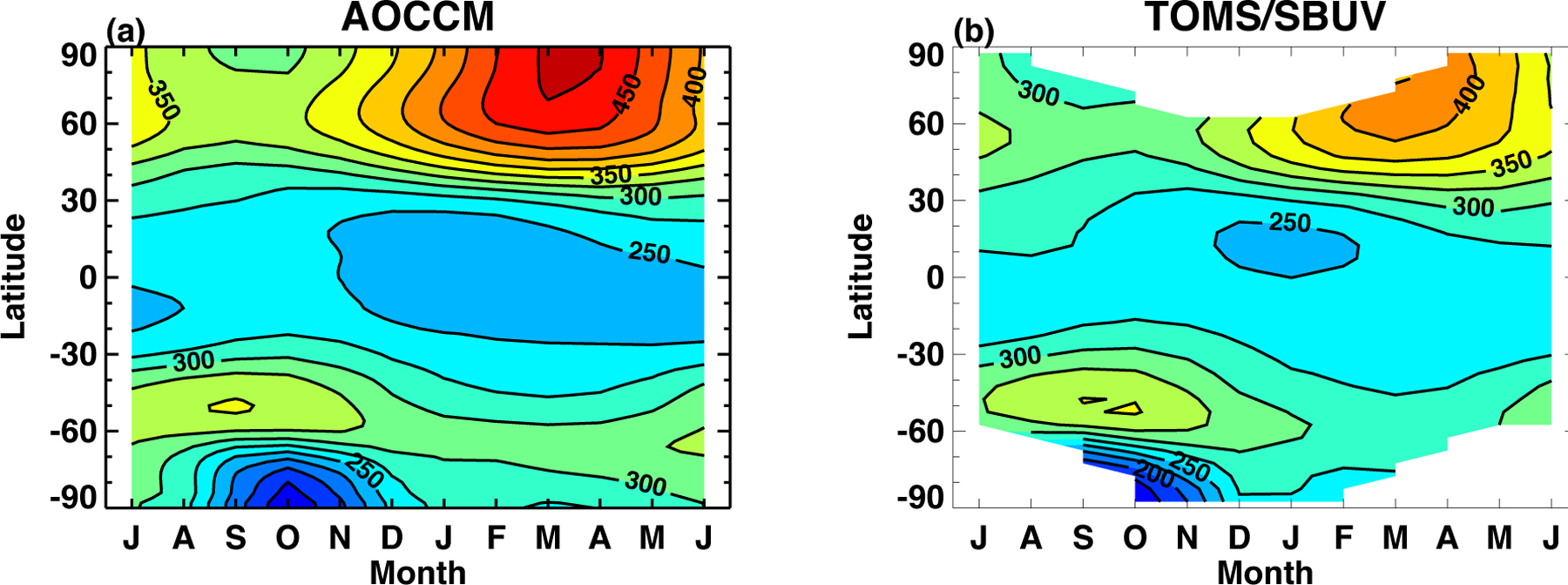
Zonal-mean total column ozone distributions in 1990–2010 as a function of month and latitude. (a) GEOS AOCCM interactive chemistry simulations. (b) Merged SBUV/TOMS total ozone data. Contour interval is 25 Dobson Unit. No observations in polar night.
The seasonal evolution of Antarctic temperatures and zonal winds is well simulated. Simulated Antarctic zonal-mean temperatures (65–90°S) and circumpolar zonal-mean zonal winds (55–70°S) are compared to NASA Modern-Era Retrospective Analysis for Research and Application reanalysis (MERRA, Rienecker et al. 2011) in Figure 2. In the lower stratosphere, the model has warm biases in the austral winter and cold biases in the austral spring (Figure 2b). The magnitude of the Antarctic temperature errors is within the range in the CCMVal-2 models (Eyring et al. 2006). In general the simulated circumpolar zonal winds have westerly biases (Figure 2d). The largest westerly biases are found in spring, which is associated with the model spring “cold-pole” error. The model Antarctic polar vortex persists longer and breaks up later and higher than observed. The spring “cold-pole” and late polar vortex break up are longstanding biases in the middle atmosphere models (Eyring et al. 2006), which are possibly due to missing orographic gravity wave drag around 60°S in the models (McLandress et al. 2011). Coupling with chemistry and ocean does not appear to reduce these biases.
Figure 2:
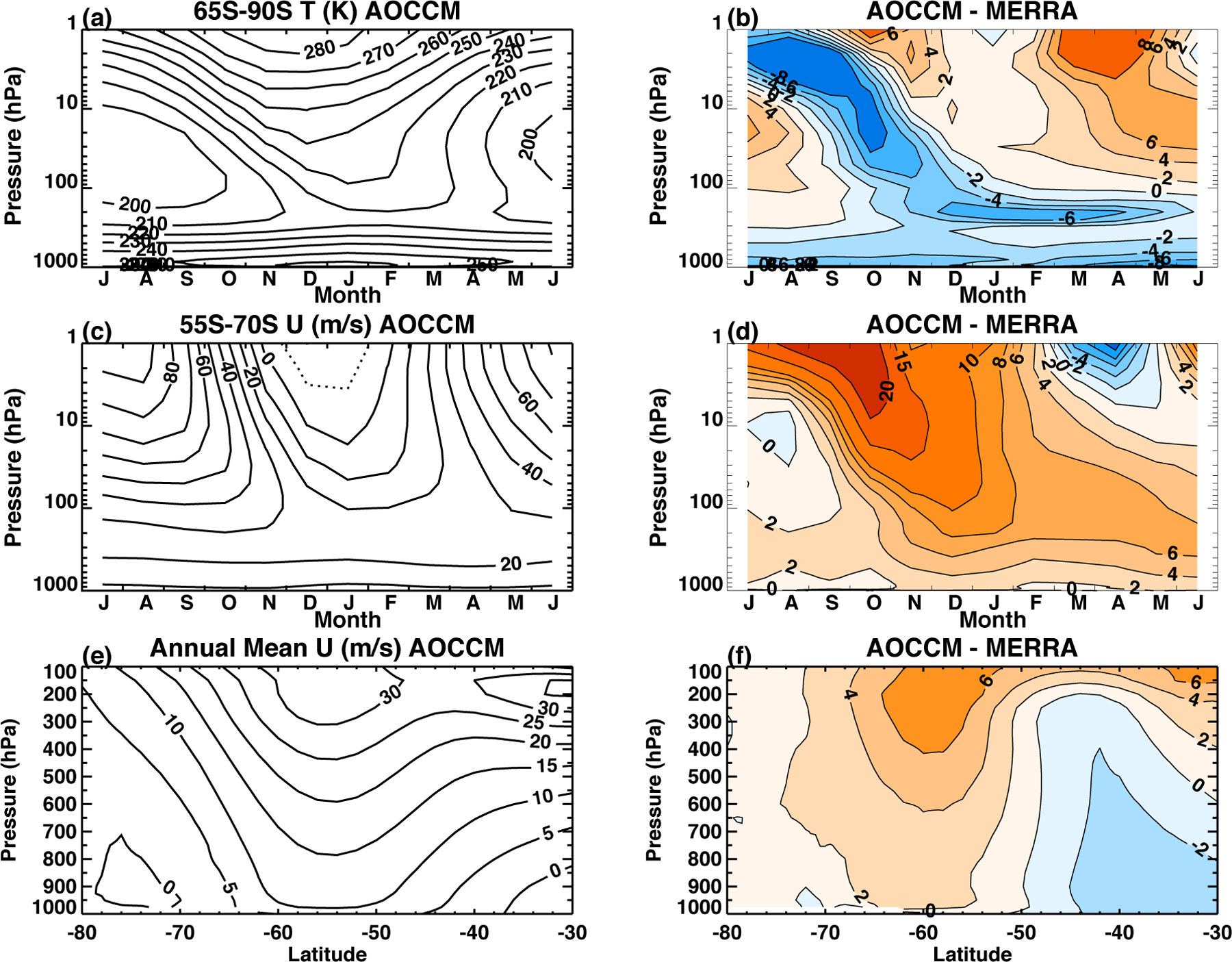
(a) Climatological seasonal cycle of Antarctic zonal-mean temperatures (averaged over 65°S to 90°S) in 1990–2010 in the GEOS AOCCM simulations and (b) the differences between the simulations and MERRA reanalysis. (c) Climatological seasonal cycle of Antarctic circumpolar zonal-mean zonal winds (averaged over 55°S to 70°S) in the AOCCM simulations and (d) the differences between the simulations and MERRA. (e) Climatological annual-mean zonal-mean zonal winds in the Southern Hemisphere in the AOCCM simulations and (f) the differences between the simulations and MERRA.
The simulated tropospheric jet has a near barotropic structure and is centered at ~ 55°S (Figure 2e). The model has westerly biases poleward of 50°S and easterly biases equatorward of 50°S (Figure 2f). This dipole pattern means that the simulated tropospheric jet is too close to the pole, which is associated with the year-round cold pole biases in the troposphere (Figure 2b).
Surface wind-stress plays a key role in the coupled atmosphere-ocean climate system. It is a major driver of the ocean circulation, and it also significantly affects the structure of sea surface temperature, sea level, and Ekman transport. Figure 3a shows the simulated annual-mean zonal wind-stress climatology. The zonal wind-stress is mostly easterly in the tropics and subtropics, and westerly in the extratropics, reflecting the surface zonal wind pattern. The most prominent feature in Figure 3a is the zonally-coherent westerly maxima in the 40°–65°S latitudinal band. This powerful surface forcing is important in driving the Antarctic Circumpolar Current (ACC), which has profound implications on the Southern Ocean Meridional Overturning Circulation (MOC). The strength and location of the simulated peak westerly wind-stress over the Southern Ocean greatly influence simulations of the Southern Ocean (Russell et al. 2006).
Figure 3:
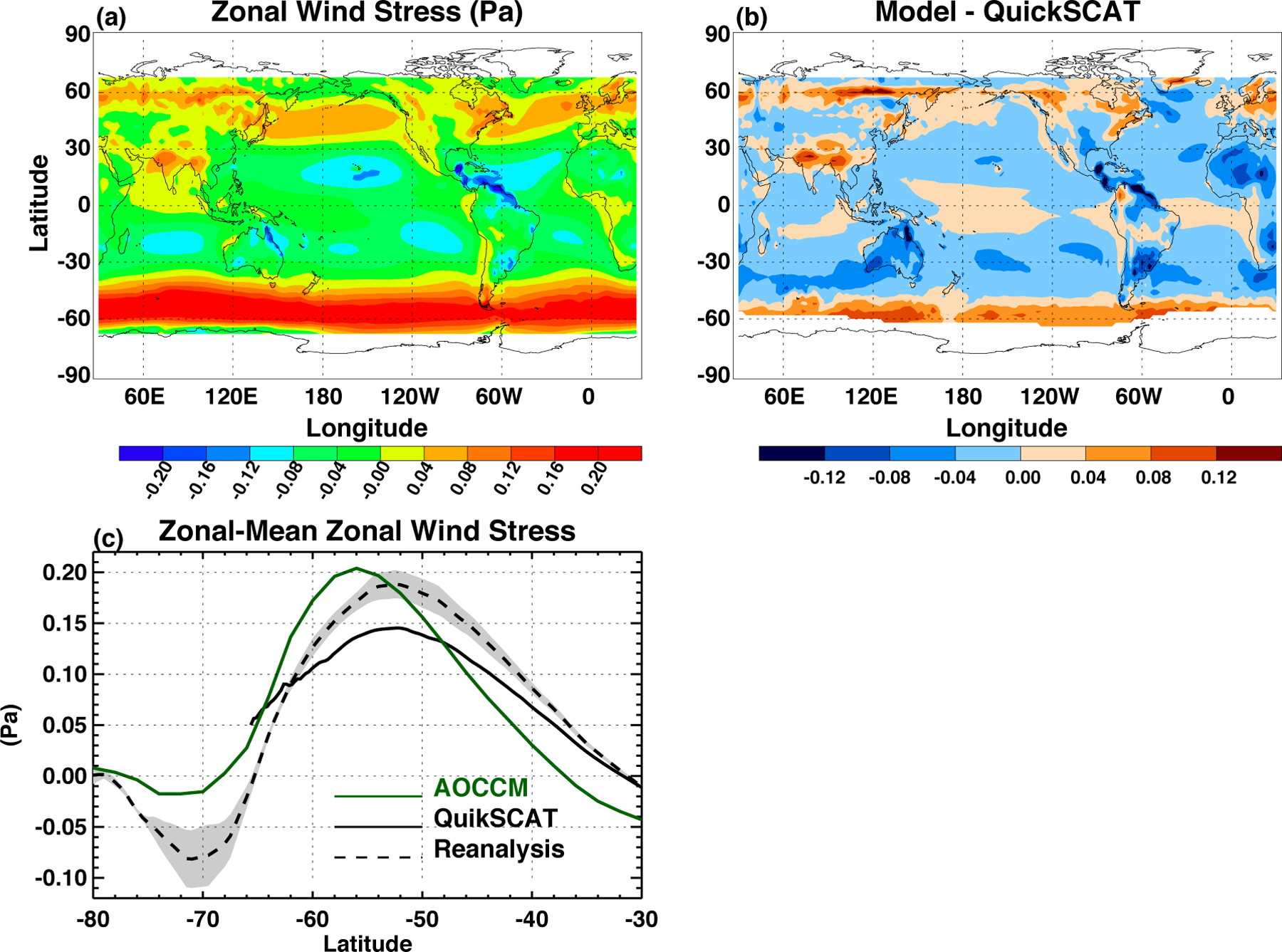
(a) Annual-mean zonal surface wind-stress climatology in 1990–2010 in the GEOS AOCCM simulations. (b) Zonal wind-stress climatology differences between GEOS AOCCM simulations and the Quick Scatterometer (QuikSCAT) observations. (c) Zonal-mean zonal wind-stress climatology in the Southern Hemisphere in the QuikSCAT (black solid), reanalysis (black dashed), and GEOS AOCCM simulations (green). The reanalysis data is the average of four datasets: MERRA, NCEP-NCAR, NCEP-DOE, and ERA-Interim. Shading shows the standard deviation of the four reanalyses climatology.
We use satellite measurements and reanalysis data to assess the simulated surface wind-stress climatology. The satellite measurements are from NASA Quick Scatterometer (QuikSCAT), which provided 11 years’ (September 1999 – October 2009) wind-stress observations. The reanalysis data we use is the average of four datasets: MERRA, the National Centers for Environmental Prediction - National Center for Atmospheric Research (NCEP-NCAR) Global Reanalysis 1 (Kalney et al. 1996), NCEP-Department of Energy (DOE) Reanalysis 2 (Kanamitsu et al. 2002), and the European Centre for Medium-Range Weather Forecast Interim Re-Analysis (ERA-Interim, Dee et al. 2011). Figure 3b shows the map of the differences between GEOS AOCCM and QuikSCAT observations. In general the simulated zonal wind-stress has easterly biases in the low and middle latitudes and westerly biases in the high latitudes. In the SH, the model biases have a dipole structure with westerly and easterly biases poleward and equatorward of ~ 50°S, respectively. These biases are consistent with those in the tropospheric jet (Figure 2f). Figure 3c compares the zonal-mean wind-stress climatology in the SH between the model, QuikSCAT, and the reanalysis. The model does not represent the location and strength of the maximum westerly over the Southern Ocean. The simulated peak westerly wind-stress is located 4° southward of the peak latitude in QuikSCAT and the reanalysis. The simulated peak magnitude is 25% stronger than the QuikSCAT, although it is only slighter larger than the maximum in the reanalysis. The biases in the surface wind-stress’s latitudinal structure are consistent with those in the tropospheric jet (Figure 2f). We want to point out that GEOS-5 simulated wind-stress climatology is comparable to the CMIP models, almost all of which perform poorly on the location and strength of the maximum westerly over the Southern Ocean (Swart and Fyfe 2012; Lee et al. 2013).
We should keep in mind that reanalysis data are not observations. Derived diagnostics in the reanalysis such as surface wind-stress are not constrained by observations and could have large errors. Figure 3c shows that while reanalysis data agree with QuikSCAT in the location of the maximum westerly, they have consistent westerly biases between 30° and 60°S. The wind-stress climatology in the four reanalysis datasets agrees well with each other (not shown), but the wind-stress trends are very different among the four datasets (Swart and Fyfe 2012). This will be discussed in more detail in the next section.
Figure 4 shows the simulated annual-mean sea surface temperature (SST) and sea surface salinity (SSS) climatology and their differences from observations. Compared with the Reynolds SST analysis (Reynolds et al. 2002), the model tends to have warm biases in the low latitudes and cold biases in the high latitudes. Large positive errors are found off the west coast of the tropical North America, South America, and Africa. These are common errors in climate models, which are partly due to weak coastal upwelling in these regions (Griffies et al. 2009). They are also closely related to the biases in the surface cloud radiative forcing. The simulated eastern Pacific/Atlantic stratus cloud decks are not attached to the coast, but are displaced to the west, giving warm errors near the coast and cold errors over subtropical gyres (Molod et al. 2012). This is also a common deficiency in the CMIP models (Laura and Hamilton 2013; Calisto et al. 2014). The largest SST errors are in the North Atlantic, which are caused primarily by a very weak Atlantic Meridional Overturning Circulation (AMOC) in the model. The weak AMOC leads to weak poleward heat transport to the North Atlantic and large cold biases in that region. The weak AMOC and the associated large North Atlantic SST errors are serious issues. There is ongoing research to address these issues.
Figure 4:

(a) Annual-mean sea surface temperature (SST) climatology in 1990–2010 in the GEOS AOCCM simulations and (b) the differences between the modeled SST and Reynolds data. (c) Annual-mean sea surface salinity (SSS) climatology in 1990–2010 in the GEOS AOCCM simulations and (d) the differences between the modeled SSS and Levitus data.
The model simulates well the SSS over the Southern Ocean except near the Antarctic continent and South America where the model has positive salinity errors in comparison to the Levitus SSS data (Levitus 1982). The model tends to have fresh biases in regions of low salinity, e.g., the tropical west and southwest Pacific and tropical Indian Ocean. Large positive SSS errors are found in the Arctic, a common bias in the AOGCMs (e.g. Delworth et al. 2006). In the North Atlantic the large fresh bias is related to the weak AMOC. Other primary sources for the salinity bias are wrong precipitation patterns, river discharge that is not well diffused, and parameterization of exchange with marginal seas. The Southern Ocean MOC is particularly efficient in exchange of heat and carbon between the surface and the deep ocean (Marshall and Speer 2012), and hence it plays an essential role in modulating regional and global climate. The MOC can be divided into a mostly wind-driven Eulerian circulation and an eddy circulation. Figures 5 shows the annual-mean Eulerian and eddy MOC streamfunction. The Eulerian MOC includes a clockwise upper cell (40°–65°S, 0–3000m), a counter-clockwise lower cell (30°–55°S, 2500–4500m), and another counter-clockwise cell south of 65°S. There are no observations of the Southern Ocean MOC, but the structure and strength of the Eulerian MOC shown in Figure 5 are similar to those reported in the CMIP3 (Sen Gupta et al. 2009) and CMIP5 (Downes and Hogg 2013) models. The eddy circulation is parameterized using the Gent and McWilliams (1990) scheme, because the coarse resolution of the ocean model cannot resolve fine-scale ocean eddies. The parameterized eddy circulation tends to have the opposite sign of the Eulerian circulation, but is much weaker than the Eulerian circulation. The maximum strength of the eddy MOC is 6 Sverdrups, whereas the strength of the Eulerian upper cell is 36 Sverdrups. Therefore the net, or the residual, MOC is dominated by the Eulerian component in the SH extratropics. For reference, the strength of the eddy MOC in the CMIP5 models ranges from 7 to 20 Sverdrups (Downes and Hogg 2013). Thus the eddy MOC in GEOS-5 is weaker than, but comparable to the CMIP5 models.
Figure 5:
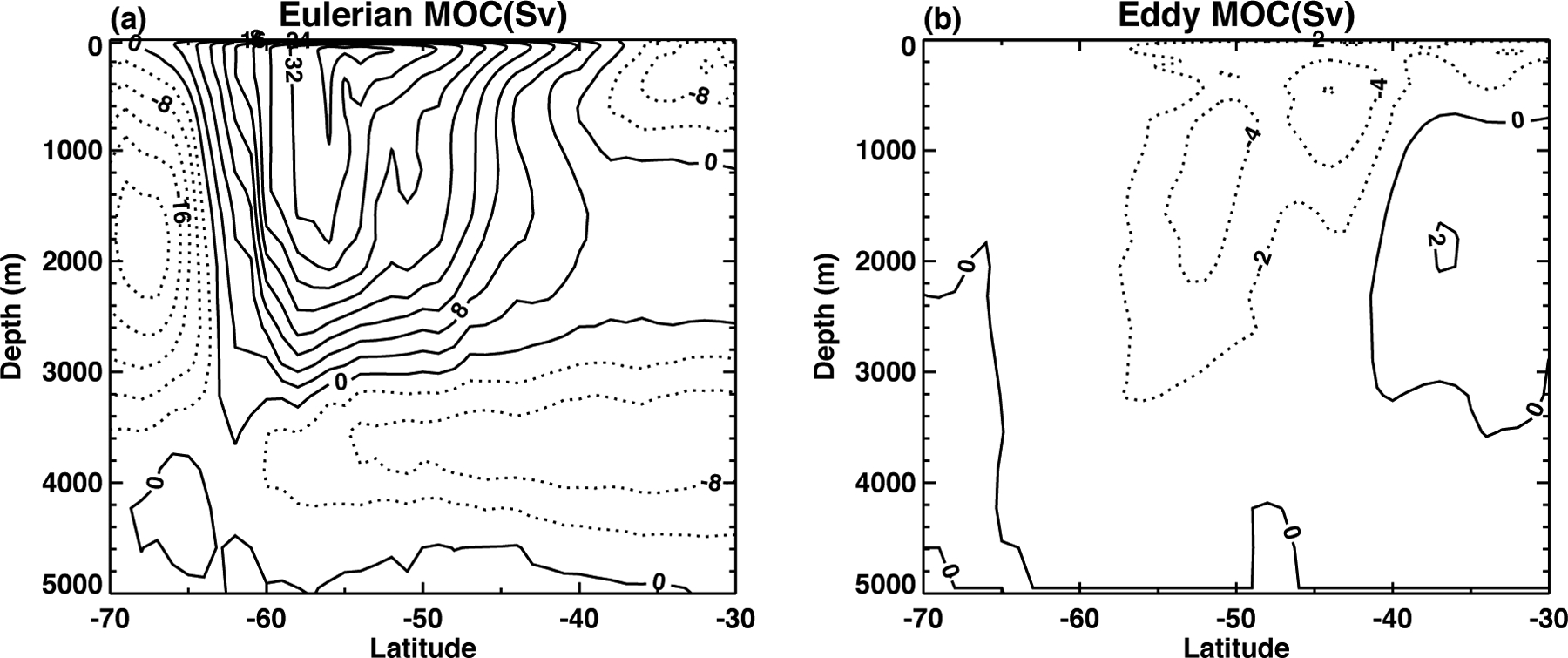
(a) Climatological Southern Ocean annual-mean Eulerian Meridional Overturning Circulation (MOC) streamfunction in 1990–2010 in the GEOS AOCCM simulations. (b) Same as (a), but for the parameterized eddy MOC streamfunction. Contour interval is 4 and 2 Sv for the Eulerian and eddy streamfunction, respectively.
Antarctic sea ice has a large seasonal cycle with minimum and maximum coverage in February and September, respectively. The simulated seasonal cycle of the Antarctic sea ice extent (SIE) is compared to the National Snow and Ice Data Center observations in Figure 6. The model simulates well the timing and magnitude of the February SIE minimum and the recovery of the Antarctic sea ice from March to August. However, the simulated SIE maximum occurs in August, one month before the observed maximum in September. These results are within the large spread of Antarctic SIE in the CMIP5 models (Turner et al. 2013).
Figure 6:
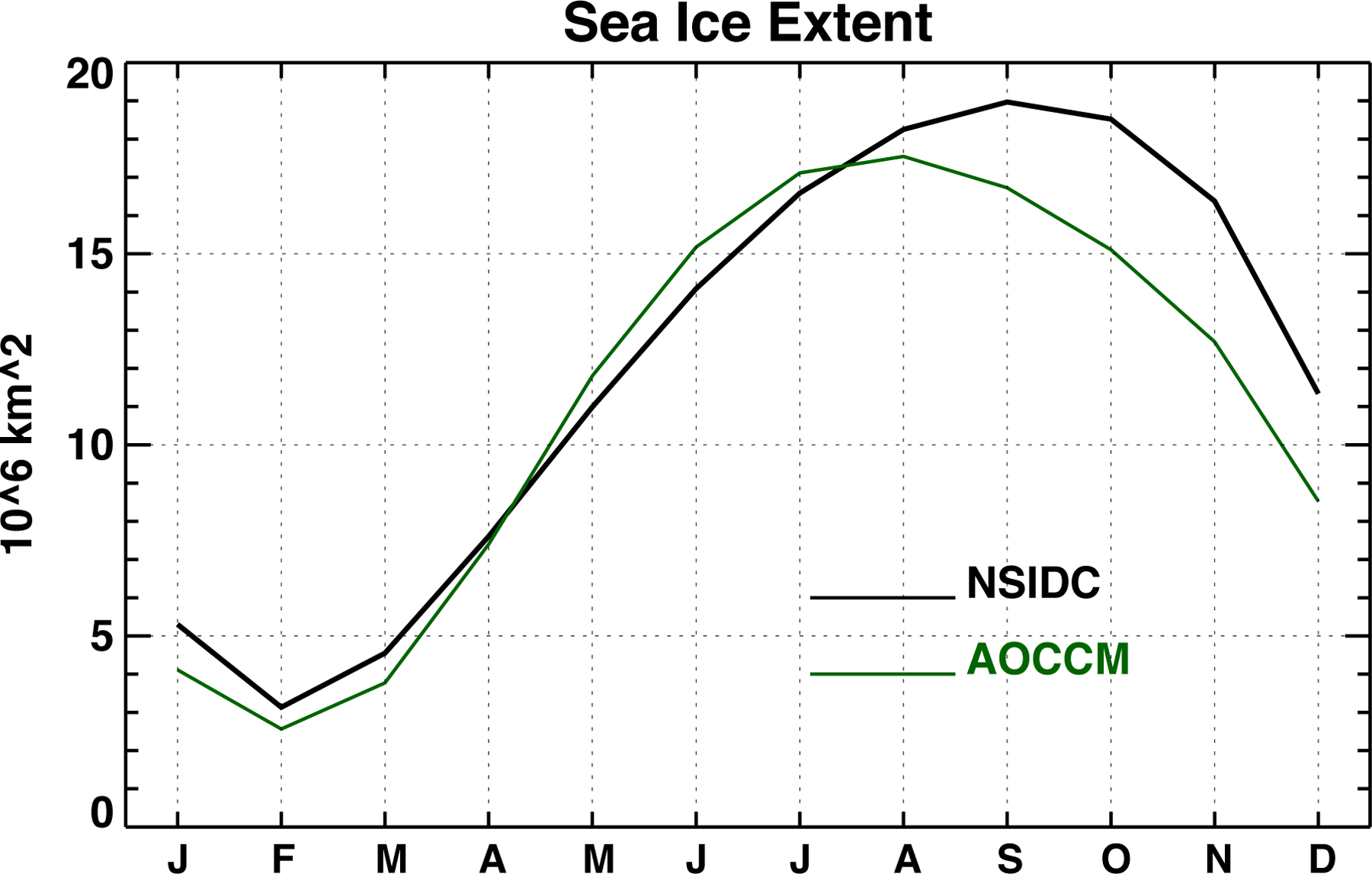
Climatological Antarctic sea ice extent seasonal cycle in 1990–2010 in the GEOS AOCCM simulations (green) and the National Snow and Ice Data Center observations (black).
In summary, GEOS AOCCM reasonably simulates the Antarctic and Southern Ocean climatology. Overall this model’s performance is comparable to current start-of-the-art climate models.
4. Impacts of Interactive Chemistry on Climate Change in the Antarctic and Southern Ocean
The interactive and prescribed simulations have different zonal-mean ozone climatology. Figure 7a compares the Antarctic (65°–90°S) total ozone seasonal cycle between TOMS/SBUV, the interactive and the prescribed runs. In October, the interactive simulations have a 207 DU ozone hole, while the prescribed simulations are 217 DU, and the observed October total ozone is 210 DU. The 10 DU ozone hole differences between the two simulations are caused by temporal smoothing of the parameterized chemistry. The parameterized chemistry sets the prescribed monthly-mean ozone from the interactive runs as the middle-month value, then interpolates linearly to determine ozone concentrations at every time step. This method is commonly used in other non-interactive chemistry models (Sassi et al. 2005; Neely et al. 2014). The problem with this method is that it acts to temporally smooth the monthly variations and thus underestimates the magnitude of the maximum/minimum monthly-mean ozone values in the interactive runs, resulting in high ozone biases in October when ozone reaches minimum.
Figure 7:
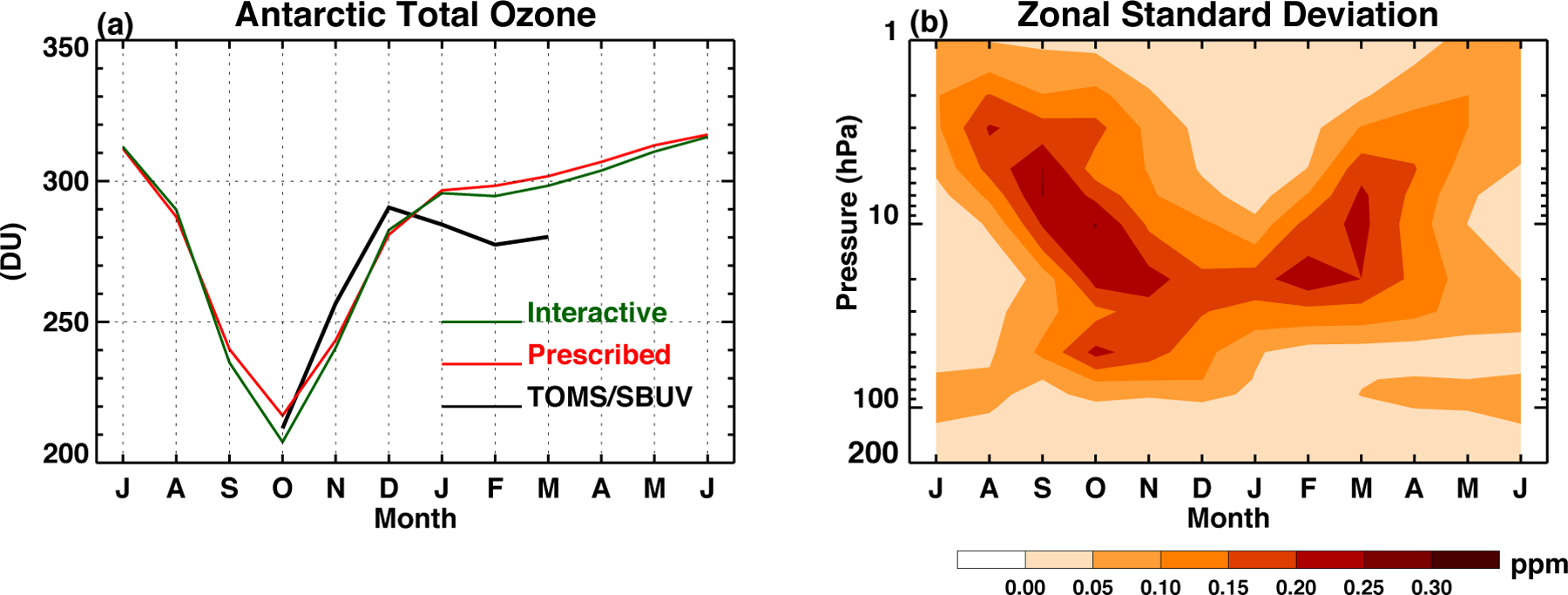
(a) Climatological seasonal cycle of Antarctic total ozone (averaged over 65°S to 90°S) in 1990–2010 for SBUV/TOMS (black), interactive chemistry (green) and prescribed ozone (red) simulations. (b) Zonal standard deviations of Antarctic ozone (averaged over 65°S to 90°S) in the interactive chemistry simulations.
Another major deficiency of the prescribed simulations is the lack of ozone zonal asymmetries. A related issue is that the prescribed ozone is not dynamically consistent with the stratospheric circulation. In the interactive simulations Antarctic ozone exhibits maximum zonal asymmetries during austral spring when the ozone hole forms (Figure 7b). In general the ozone hole is offset from the South Pole toward the west Antarctica and the southern Atlantic Ocean, reflecting the influence of planetary waves (Grytsai et al. 2007). Large ozone zonal asymmetries are also found in February and March, which is associated with a large wave-1 structure in the geopotential height. Previous studies have shown that lacking zonal asymmetries and dynamical consistency affects the stratospheric circulation and even the tropospheric climate trends (Crook et al. 2008; Waugh et al. 2009).
Ozone biases in the prescribed runs affect simulations of Antarctic stratosphere temperatures. Figure 8a shows that the interactive simulations tend to have lower temperatures in winter and spring and higher temperatures in summer and fall than the prescribed simulations. Shading indicates that the differences (interactive minus prescribed) are statistically significant at the 5% level based on a two-sample t-test. The patterns of temperature differences do not exactly match those of ozone differences (Figures 8a–b), e.g., the cooling in the lower stratosphere during austral winter and the warming near 200 hPa during February-March-April-May. This indicates that radiative forcing is not the sole factor driving temperature differences. Figures 8c and 8d show differences in the dynamical and shortwave heating rates, respectively. The magnitude of dynamical heating differences is comparable to or even stronger than that of shortwave heating differences. Comparing Figures 8a and 8c clearly shows that the cooling in June-July-August and the 200 hPa warming during February-March-April-May are driven by dynamical heating changes. Therefore, changes in the dynamics also play an important role in driving temperature differences (Crook et al. 2008).
Figure 8:
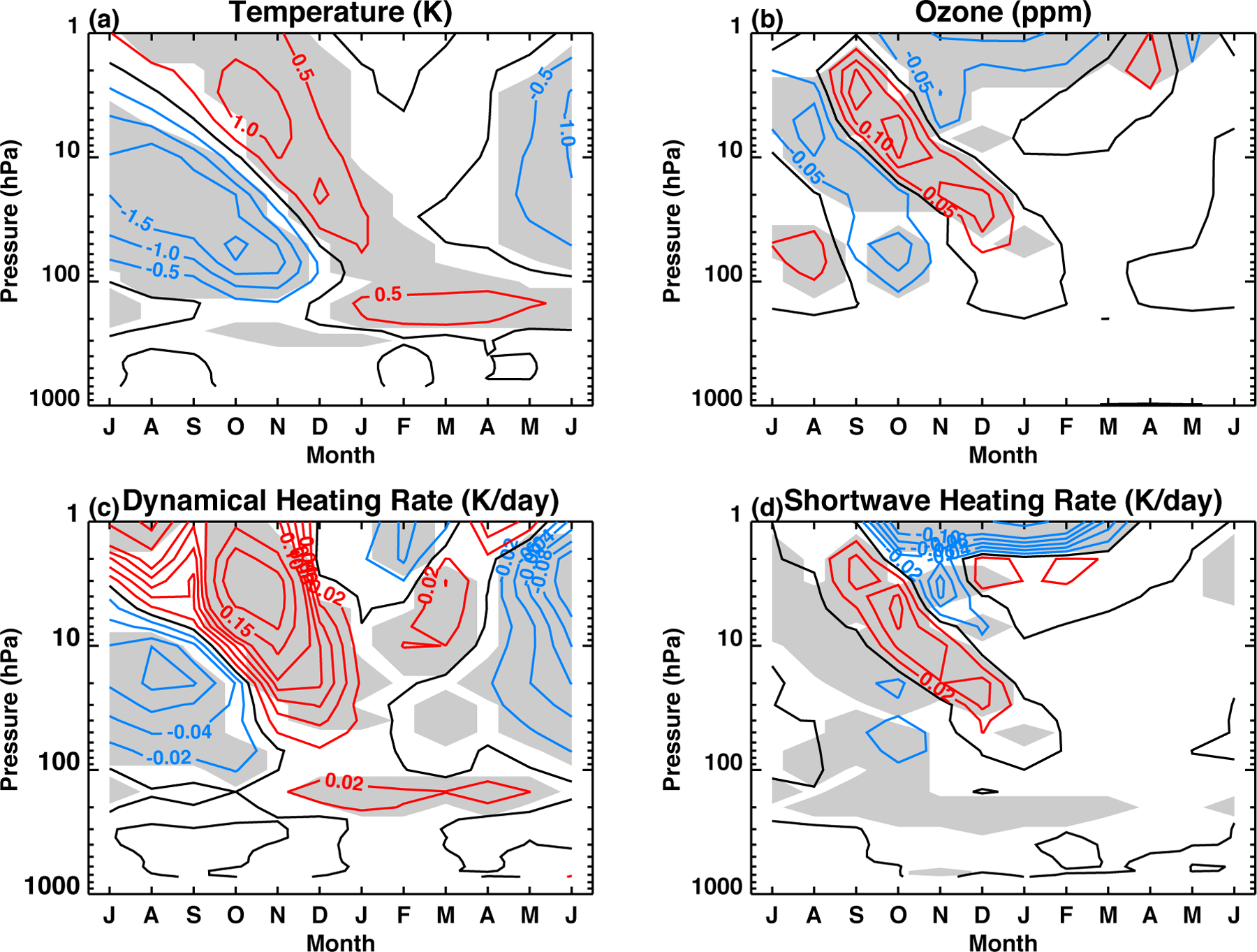
Differences in Antarctic (a) temperature, (b) ozone, (c) dynamical heating and (d) shortwave heating rate (averaged over 65°S to 90°S and 1990–2010) between the interactive chemistry and prescribed ozone simulations (interactive minus prescribed). Shading indicates that the differences are statistically significant at the 5% level based on a two-sample t-test.
As expected, differences in the shortwave heating rates have the same pattern as ozone differences except during the austral winter. The deeper October ozone hole in the interactive runs (in the lower stratosphere in October in Figure 8b, also see Figure 7a) absorbs less shortwave radiation, leading to a colder lower stratosphere in October and November. Weaker dynamical heating in October (Figure 8c) could also contribute to the lower stratospheric temperature differences in the late spring. Differences in dynamical heating reflect the response of the stratospheric wave-driven Brewer-Dobson circulation to interactive chemistry. They are associated with the lack of zonal asymmetries in the prescribed ozone, which modulates stratospheric wave driving (Nathan and Cordero 2007; Crook et al. 2008). The ozone hole also induces dynamical feedback and increases the downwelling in the Antarctic stratosphere in the austral late spring and summer (Stolarski et al. 2006; Li et al. 2008). Thus the stronger dynamical warming that propagates from the upper stratosphere in October and November to lower stratosphere in December and January is also linked to the deeper ozone hole in the interactive simulations (Figure 8c).
Interactive ozone chemistry has important impacts on simulations of climate change over the Antarctica. Figures 9a–f compare linear trends of the Antarctic temperatures (65°–90°S) and the circumpolar zonal winds (55°–70°S) in 1979–2010. Shading in Figure 9 indicates that the trends are statistically significant from zero at the 2-tailed 95% confidence interval, where the confidence interval is calculated following Santer et al. (2000). Overall the interactive and prescribed simulations have similar patterns: cooling in the lower stratosphere and intensification of the stratospheric and tropospheric westerlies during the Austral spring and summer seasons. However, the trends are stronger in the interactive runs. The maximum stratospheric cooling trend at November and 70 hPa is 3.4 and 2.9 K/decade in the interactive and prescribed runs, respectively. The peak westerly acceleration in the interactive runs is ~ 30% stronger at 20 hPa and 70% stronger at 500 hPa than in the prescribed runs. Also the peak westerly trends in the troposphere occur one month earlier in the interactive runs (December) than in the prescribed runs (January).
Figure 9:
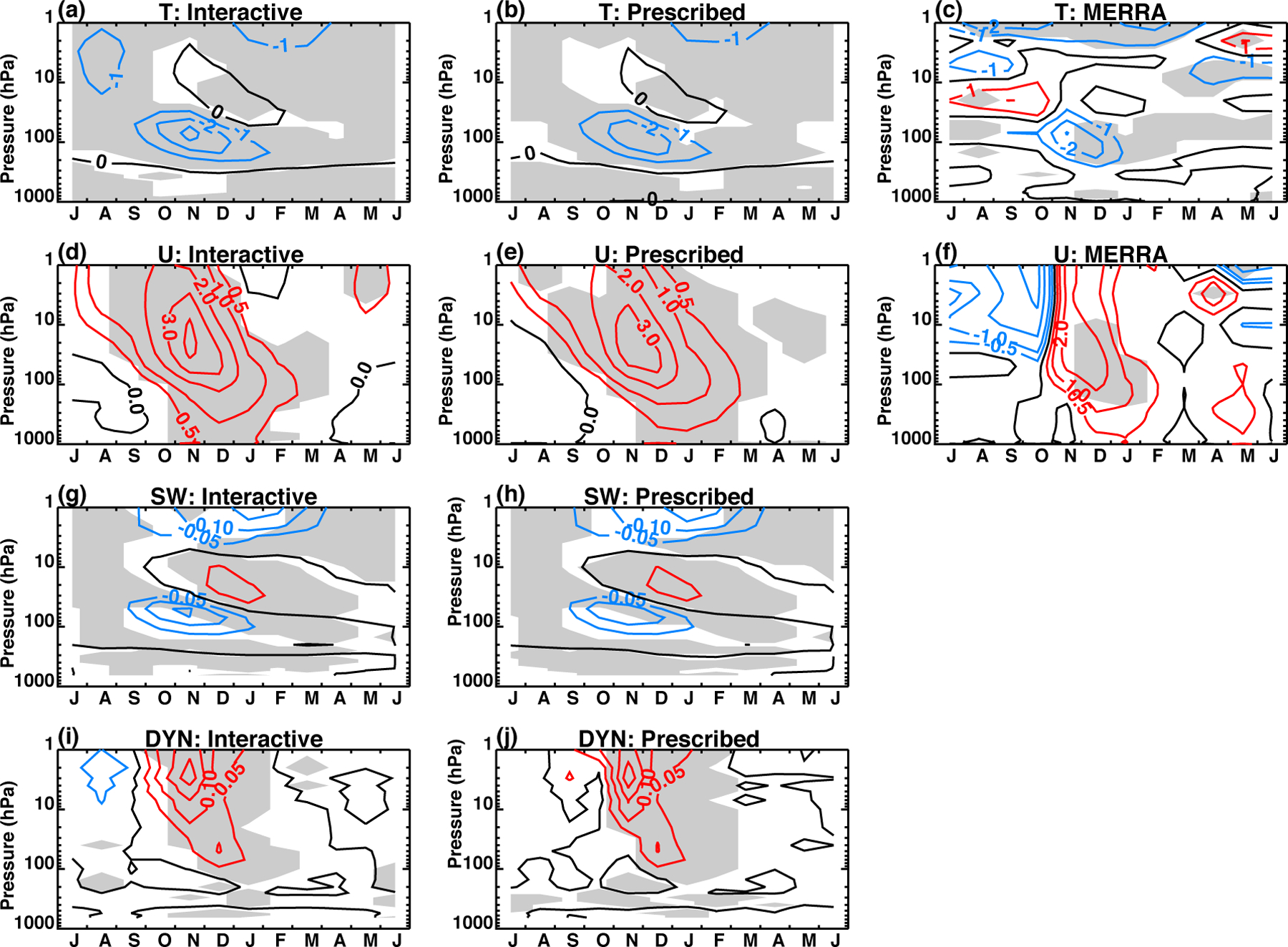
(a–c) Linear trends of Antarctic zonal-mean temperatures (65°S–90°S) in 1979–2010 in the interactive simulations, prescribed simulations, and MERRA. Unit is K/decade. (d–f) Same as (a–c), but for the circumpolar zonal-mean zonal winds (55°S–70°S). Unit is m/s/decade. (g–h) Linear trends of Antarctic shortwave heating rates (65°S–90°S) in 1979–2010 in the interactive and prescribed simulations. Unit is K/decade. (i–j) Same as (g–h), but for the dynamical heating rates. Shading indicates that the trends are statistically significant at 5% level.
The Antarctic temperature and zonal wind trends from MERRA are also shown in Figure 9. The MERRA trends are much noisier than the simulated trends particularly in the upper stratosphere. The maximum lower stratosphere cooling in MERRA is 3.1 K/decade, between that of the interactive and prescribed runs. We have also found that temperature trends calculated using the Radiosonde Innovation Composite Homogenization dataset (Hamiberger et al. 2012) agree well with the MERRA trends in the lower stratosphere (not shown). As for the circumpolar westerly accelerations, the MERRA trends are smaller than both simulations in the stratosphere, but are between the interactive and prescribed runs in the troposphere.
The lower stratospheric cooling is caused by the decrease of shortwave heating (Figures 9 g–h), which is partly compensated by an increase of dynamical warming (Figures 9 i–j). The stronger cooling in the interactive simulations is mainly driven by stronger decrease of shortwave heating (Figures 9 g–h), which originates from stronger ozone depletion.
At the surface, zonal wind trend in the interactive runs is statistically significant in November-December-January (NDJ) (Figure 10). The trends in these three months are all larger than those in the prescribed runs, although the trend differences are not statistically significant. The NDJ-mean surface circumpolar westerly trend is 0.46 m/s/decade in the interactive simulations, about 70% larger than in the prescribed simulations. It is interesting to note that the relative differences of the circumpolar westerly trends amplify from the stratosphere (about 30%) to the troposphere and surface (about 70%), suggesting that interactive chemistry affects stratosphere-troposphere coupling. Hereafter we will focus on the NDJ period when climate trends in the interactive and prescribed runs have the largest differences.
Figure 10:
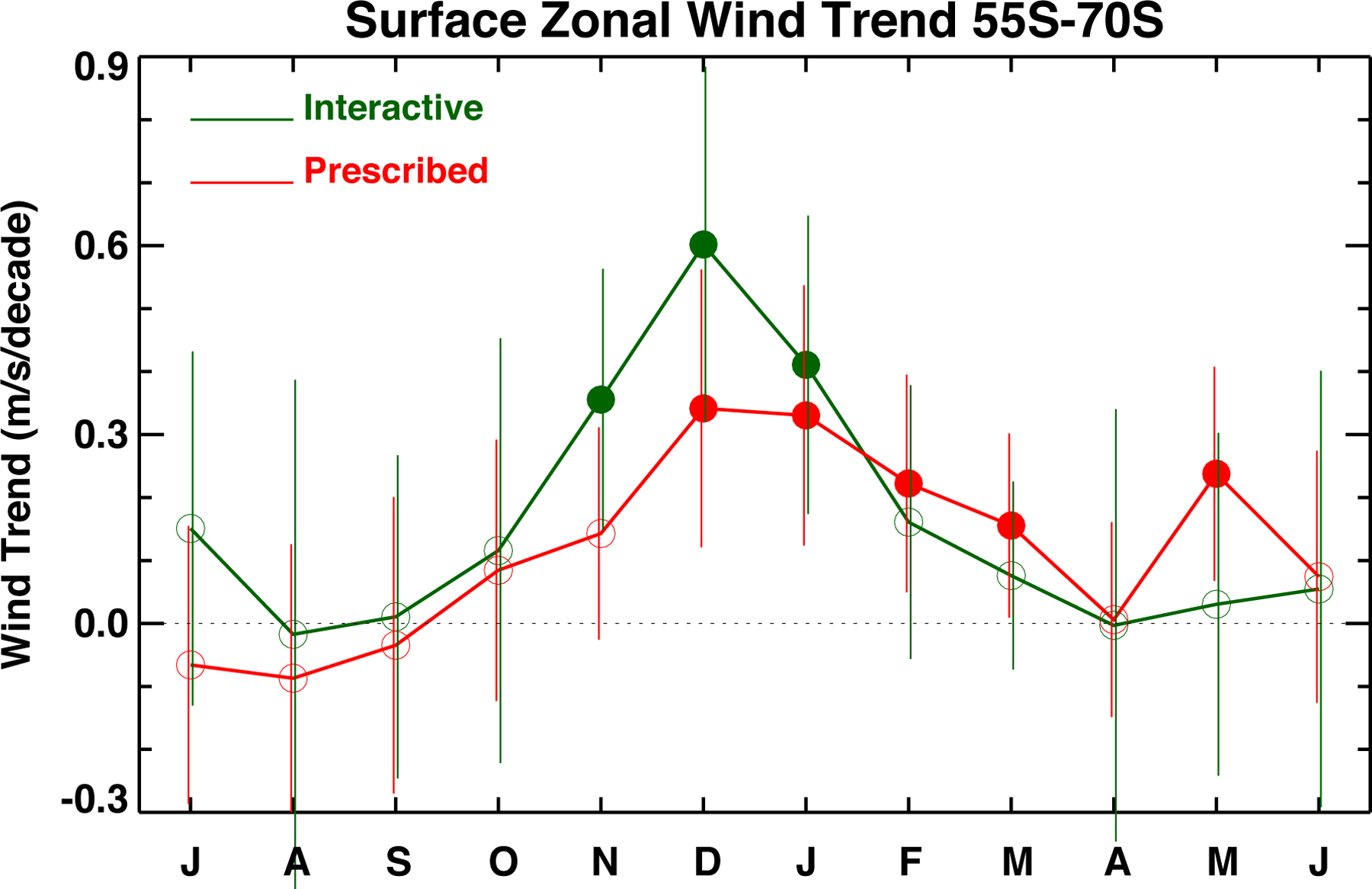
Monthly surface zonal wind trends (averaged over 55°S to 70°S) in 1979–2010 in the interactive chemistry (green) and prescribed ozone (red) simulations. Error bars (95% confidence interval) in the interactive and prescribed simulations are slightly offset to show their differences. Filled circles indicate that the trends are statistically significant at the 5% level.
Climate change in the SH middle and high latitudes during the past several decades is closely related to the shift of the SAM toward its positive polarity (Thompson and Solomon 2002). The shift of the SAM polarity is commonly illustrated as the poleward intensification of the tropospheric westerlies (Figure 11). Both runs simulate a statistically significant dipole structure of the tropospheric zonal-mean zonal wind trends during NDJ with eastward acceleration centered at 65°S and westward acceleration centered at 45°S. This dipole structure, a signature of the SAM shift, has a larger magnitude in the interactive runs. For example, the maximum eastward and westward trends at 300 hPa are respectively 1.25 and −0.8 m/s/decade in the interactive runs, which are more than 100% stronger than in the prescribed runs.
Figure 11:
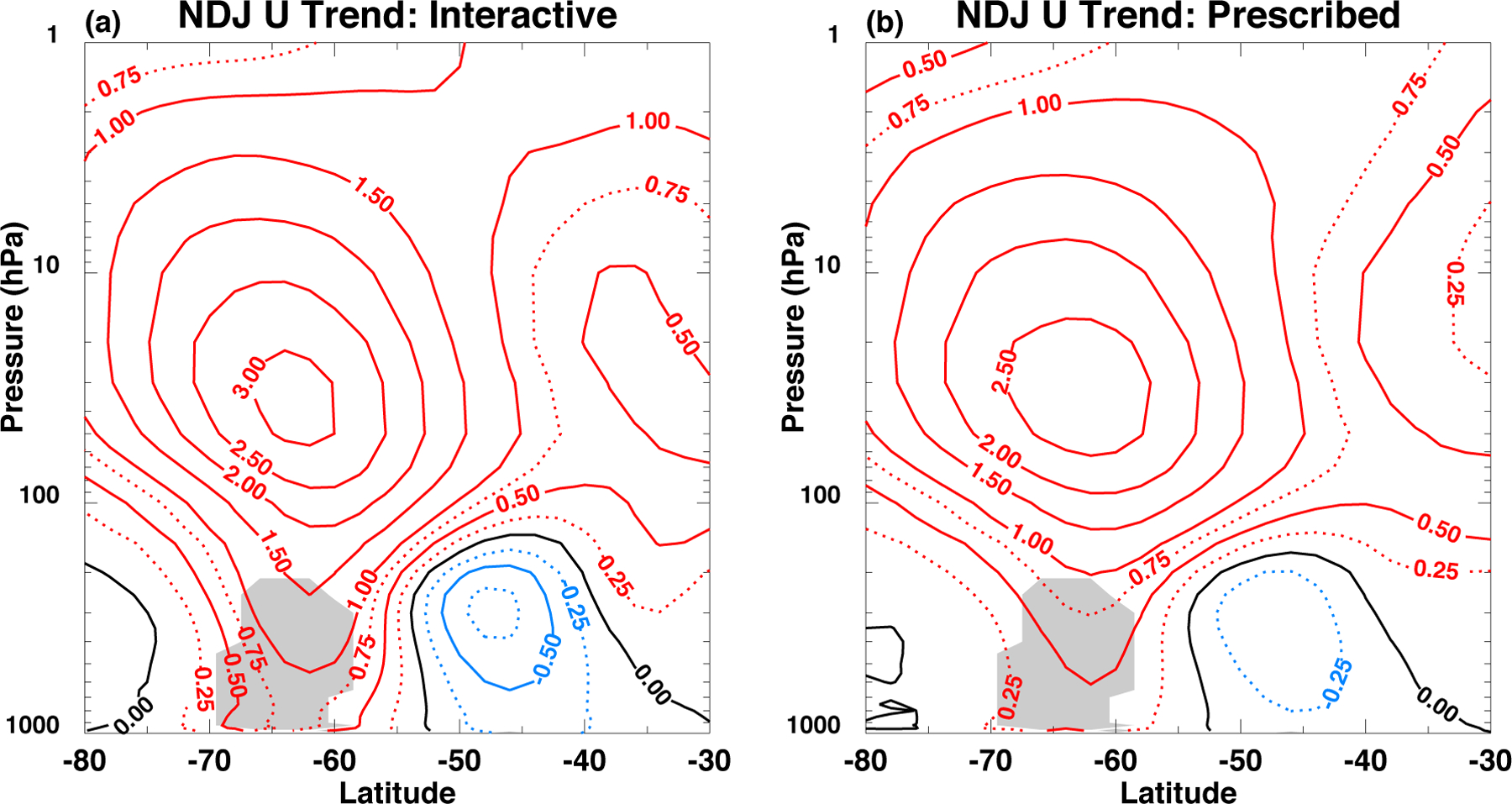
Linear trends of November-December-January zonal-mean zonal wind in 1979–2010 in (a) interactive chemistry simulations and (b) prescribed ozone simulations. Unit is m/s/decade. The trends with magnitude of greater than about 0.25 m/s/decade are statistically significant at the 2-tailed 5% level. Shading indicates that the trends in the interactive simulations are significantly stronger than those in the prescribed simulations at the 5% level using a one-tailed t test.
The amplification of zonal wind response to interactive chemistry from stratosphere to troposphere and surface is clearly seen in Figure 11. The relative difference of the maximum westerly trend is about 20% in the stratosphere, and increases to more than 100% below 300 hPa. Neely el al. (2014) showed similar results (see their Figure 3), but they did not discuss this effect. Noting that the trends in the interactive simulations are always stronger, we use a 1-tailed t test to find out whether these differences are statistically significant following the method of Wigley (2006). The trend differences are not statistically significant in the stratosphere, but the interactive simulations have significantly stronger westerly accelerations than the prescribed runs between about 60°S and 70°S and from the surface to 200 hPa. We do not know what causes the enhanced tropospheric response. Indeed how the ozone hole-induced lower stratospheric westerly anomalies are propagated downward to the troposphere is not well understood (e.g., Thompson et al. 2012). Nevertheless, this amplified tropospheric response indicates a stronger stratosphere-troposphere coupling and has important implications on surface wind-stress and Southern Ocean changes.
We are particularly interested in the impacts of interactive chemistry on simulations of the SH surface wind-stress. The strong westerly surface wind-stress over the Southern Ocean directly affects Ekman transport and the meridional overturning circulation. Through its impacts on the surface wind-stress, the stratospheric ozone chemistry could affect Southern Ocean circulation. Figure 12a compares the NDJ zonal-mean surface zonal wind-stress trends in the interactive (green) and prescribed (red) simulations. The trends in both simulations have the same latitudinal structure with a westerly and an easterly maximum centered at 62°S and 46°S, respectively. The maximum westerly and easterly trends in the interactive runs are about two times larger (statistically significant at the 5% level) than those in the prescribed runs, consistently with the significantly stronger tropospheric and surface zonal wind trends in the interactive runs shown in Figure 11.
Figure 12:
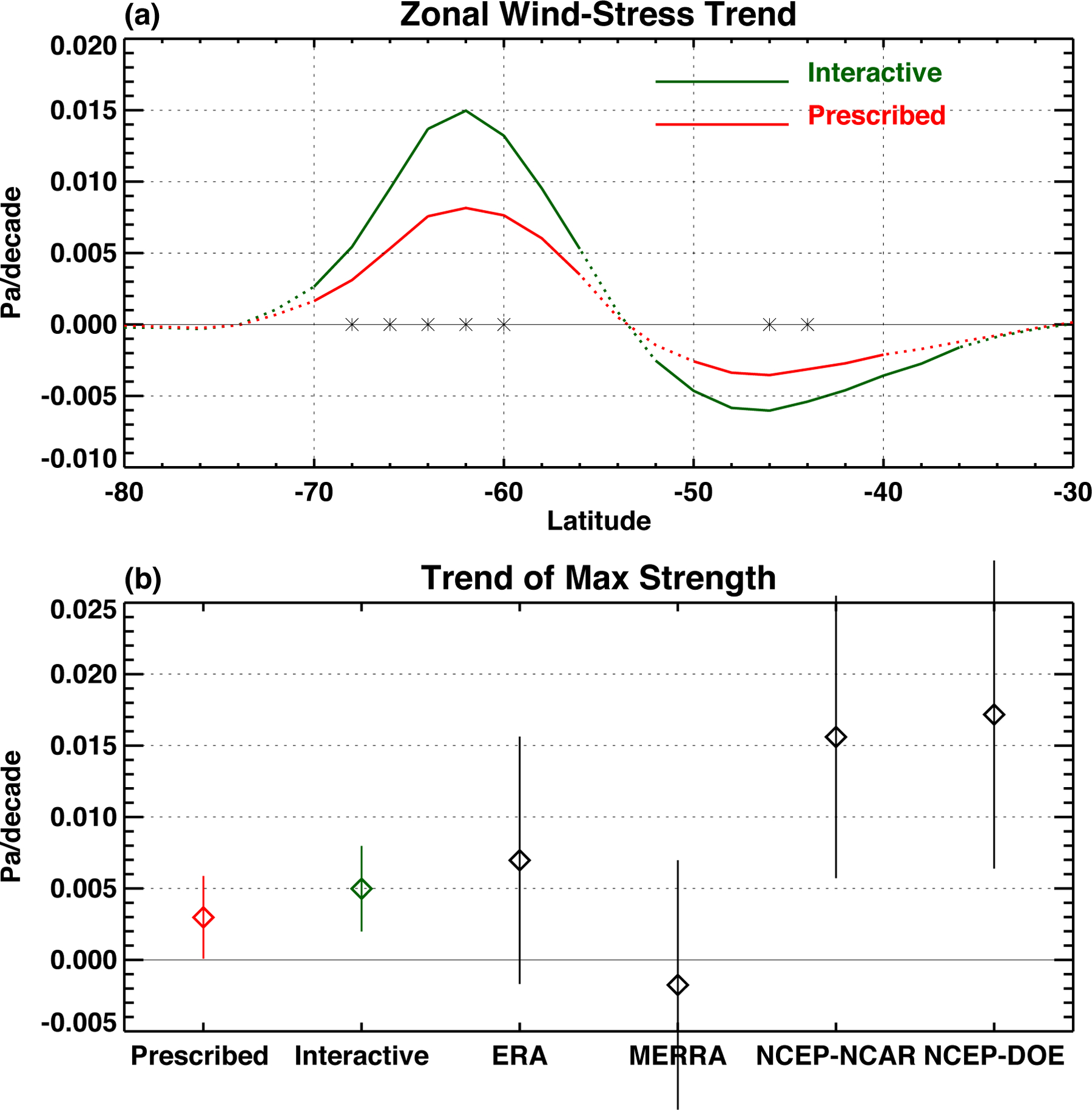
(a) Trends of the November-December-January zonal-mean surface zonal wind-stress in 1979–2010. Green and red lines are results from the interactive chemistry and prescribed ozone simulations, respectively. Solid lines represent that the trends are statistically significant from zero at the 95% confidence interval. Asterisks indicate where the trends in the interactive simulations are significantly stronger than those in the prescribed simulations.. (b) Trends of the NDJ maximum surface zonal wind-stress in the Southern Hemisphere in 1979–2010. The error bars show the 95% confidence interval.
A commonly used diagnostic for surface wind-stress change is the trend of the maximum strength (Swart and Fyfe 2012). We use this diagnostic to evaluate how interactive chemistry improves the simulation of wind-stress increase compared with the reanalysis data. Figure 12b shows that the trend of the NDJ westerly wind-stress maximum in the interactive runs is 60% larger than that in the prescribed runs. The trend in the interactive simulations (0.005 Pa/decade) is still much smaller than the average trend of the four reanalysis (0.009 Pa/decade). However, the reanalysis trends have large spread: the ERA-Interim and MERRA do not have a statistically significant trend, and the NCEP-NCAR and NCEP-DOE trends are more than twice the ERA-Interim trend. These larger uncertainties in the reanalysis make it difficult to validate the improvements of interactive chemistry on simulated surface wind-stress changes.
The larger increase of surface forcing in the interactive runs significantly affects the simulated Southern Ocean circulation changes. A comparison of the NDJ trends in the zonal-mean surface zonal and meridional currents is shown in Figure 13a–b. The westerly and northerly trend maxima are about two times larger in the interactive runs than in prescribed runs and these trend differences are statistically significant, consistent with the differences in the surface wind-stress trends (Figure 12a). This similarity is due to the direct dynamical effect of surface wind-stress on the surface Ekman transport. The trends of the ocean currents, particularly the meridional current, decrease rapidly with depth (Figures 13 c–f). The interactive runs simulate significantly larger westerly and northerly trends poleward of about 55°S. The westerly current trend differences extend from surface to the deep ocean (only the upper 100 meters are shown in Figures 13 c–d), but the northerly current trends differences are limited to the upper 80 meters (Figures 13 e–f).
Figure 13:
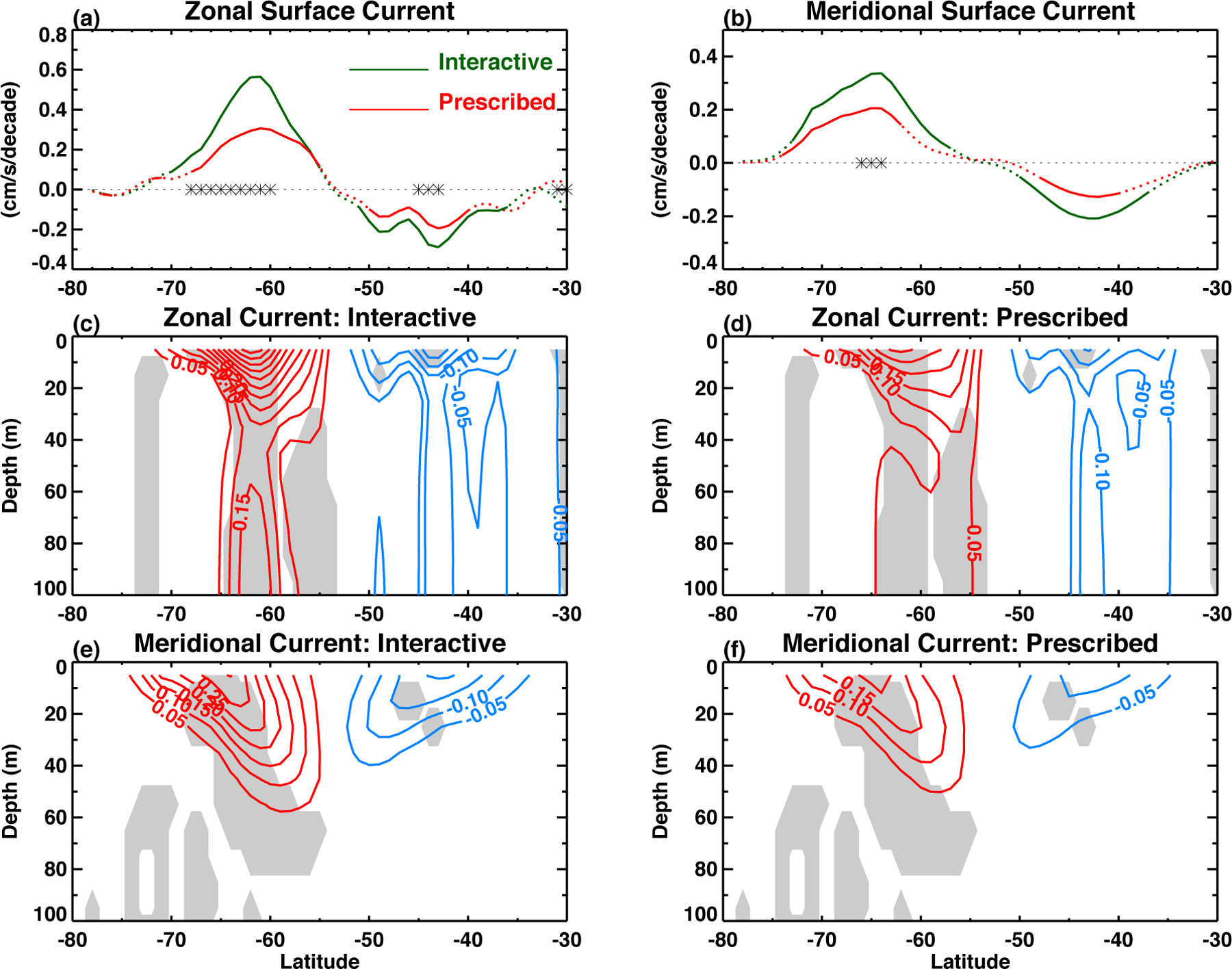
(a) Trends of the November-December-January zonal-mean zonal surface ocean currents in 1979–2010 in the interactive chemistry (green) and prescribed ozone (red) simulations. Solid lines represent that the trends are statistically significant from zero at the 95% confidence interval. Asterisks indicate where the trends in the interactive simulations are significantly stronger than those in the prescribed simulations. (b) Same as (a), but for the meridional surface currents. (c) Trends of the NDJ zonal-mean zonal ocean currents in 1979–2010 in the interactive simulations. (d) Same as (c), but for the prescribed simulations. Trends with magnitude larger than 0.05 cm/s/decade are statistically significant from zero. Shading in (c) and (d) indicates where the zonal current trends in the interactive simulations are significantly stronger than those in the prescribed simulations at the 1-tailed 5% level. (e) Trends of the NDJ zonal-mean meridional ocean currents in 1979–2010 in the interactive simulations. (f) Same as (e), but for prescribed simulations. Shading in (e) and (f) indicates where the meridional current trends in the interactive simulations are significantly stronger than those in the prescribed simulations at the 1-tailed 5% level. Unit in all panels is cm/s/decade.
Interactive chemistry has significantly impact on changes in the Southern Ocean MOC. Figures 14 compares trends of the NDJ Eulerian MOC streamfunction. The trends are dominated by a dipole structure, indicating a poleward shift and strengthening of the upper cell. Similar trends have been reported in previous studies on the Southern Ocean MOC changes (Sigmond and Fyfe 2010; Solomon et al. 2015). The latitudinal structure and magnitude of the MOC trends are determined by the surface wind-stress (Figure 12a). Consistent with larger surface wind-stress changes, the MOC trends in the interactive runs are larger than in the prescribed runs. The differences in the MOC trends reach to below 3000 m. Most of the significantly different trends are found in the upwelling branch of the MOC poleward of 60°S. We have described in Figure 5 that the parameterized eddy MOC is much weaker than the Eulerian MOC. Similarly, the trends of the eddy MOC are much smaller than those of the Eulerian MOC (not shown). This is true for both the interactive and prescribed simulations.
Figure 14:
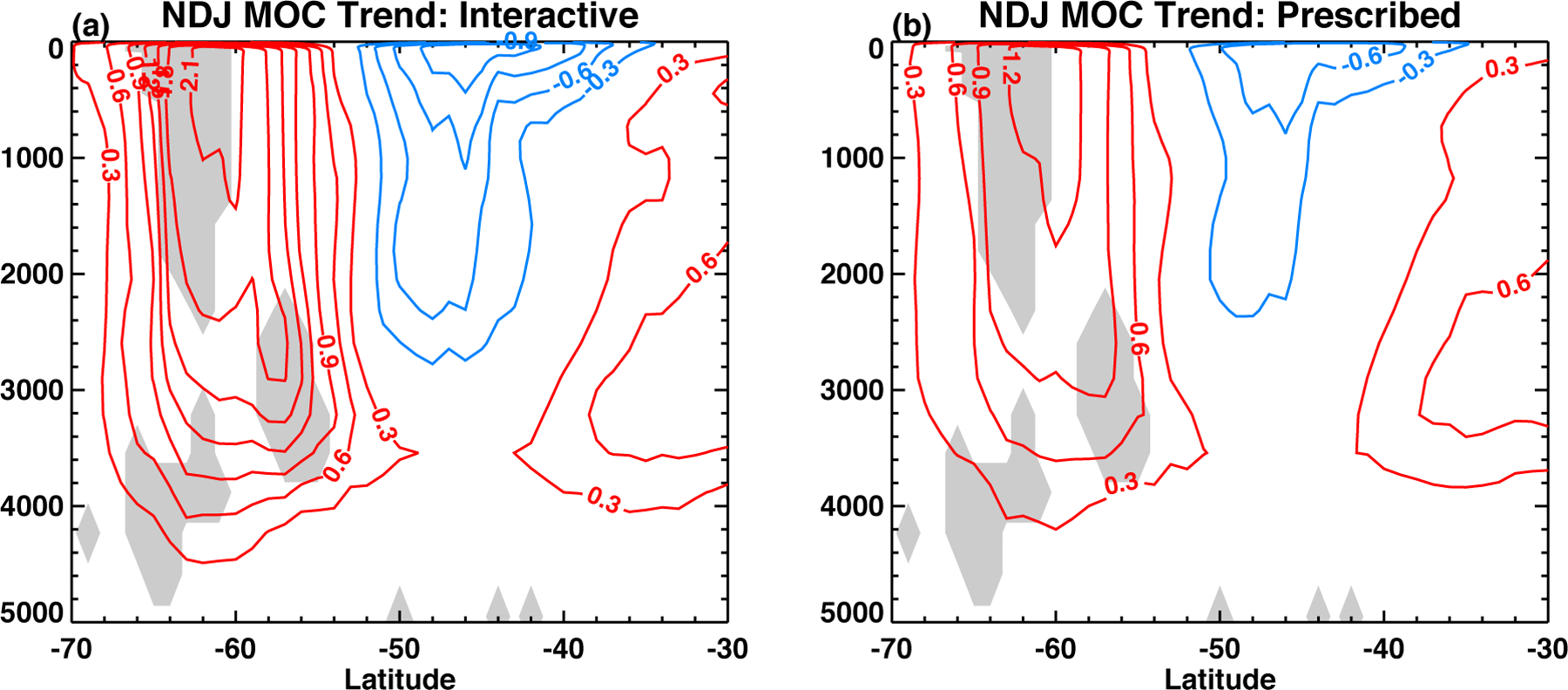
Trends of the November-December-January Southern Ocean MOC streamfunction in 1979–2010 in (a) interactive chemistry and (b) prescribed ozone simulations. Poleward of 55°S, trends with magnitude grater than about 0.3 Sv/decade are statistically significant from zero at the 2-tailed 5% level. Equatorward of 55°S, trends with magnitude greater than about 0.6 Sv/decade are statistically significant. Shading indicates where the MOC trends in the interactive simulations are significantly stronger than those in the prescribed simulations at the 1-tailed 5% level. Unit of the trends is Sv/decade.
That the interactive runs produce a stronger increase of the Southern Ocean MOC could have important implications for simulated global climate change. For instance, an enhanced upwelling of carbon-rich deep Southern Ocean water will affect the global carbon cycle (Russell et al. 2006b; Lenton et al. 2009). It should be noted, however, that there are strong debates on how the Southern Ocean eddy circulation will respond to increases of the surface wind. Some eddy-resolving ocean models simulate much stronger eddy circulation increases than in the coarse-resolution models (Spence et al. 2010; Farneti et al. 2010). In these eddy-resolving simulations, the increases of the eddy MOC compensate a larger fraction of, or even balance, the increases of the Eulerian cell, resulting in little or no changes in the residual MOC. There is no direct observational evidence to confirm whether or not the MOC has increased. Some ocean properties affected by the MOC (e.g. ventilations) show changes consistent with an increase of the MOC (Waugh et al. 2012), but other properties such as the slope of isopycnals do not show changes (Boning et al. 2008).
The differences in the Southern Ocean trends between the interactive and prescribed runs are largest during NDJ, indicating that on seasonal timescale there is no delay in the ocean circulation’s response to changes in the overlying surface forcing. In other seasons, the interactive and prescribed simulations produce similar trends of the surface wind-stress and MOC (not shown). However, the seasonal wind-stress differences have year-round impacts on Southern Ocean temperature changes. Figures 15 a–b show the climatology (contours) and trends (color shading) of the zonal-mean ocean temperature in NDJ and May-June-July (MJJ) in the interactive runs. The ocean temperature trends are corrected for model drift by subtracting the trends in the 100-year perpetual 1960 control simulation. The ocean temperature drift in the control simulation is much smaller than the forced changes in the interactive or prescribed simulations in most of the Southern Ocean (not shown). In NDJ ocean warming is strongly affected by the enhanced Ekman transport and strengthening of the MOC. At the surface the enhanced Ekman flow transports cold ocean water equatorward south of 55°S and warm water poleward north of 55°S (see Figure 13b). This leads to a very weak surface cooling at 64°S (not statistically significant) and the largest warming at 45°S, which corresponds respectively to the latitudes of the maximum northerly and southerly trends of the surface meridional ocean currents (Figure 13b). The large warming at 45°S extends to the deeper ocean due to strong Ekman pumping. Near the continent below about 100 m the ocean temperature increases with depth, thus the strengthening of the MOC upwelling increases the upward ocean heat transport, causing enhanced warming just below the weak surface cooling. Changes in the Ekman transport and MOC are much weaker and not statistically significant in other seasons (not shown). However, due to the larger thermal inertia of the ocean, the overall pattern of ocean temperature trends in MJJ (Figure 15b) and other seasons is similar to that in NDJ, although the near-surface dipole structure at 64°S disappears in other seasons.
Figure 15:
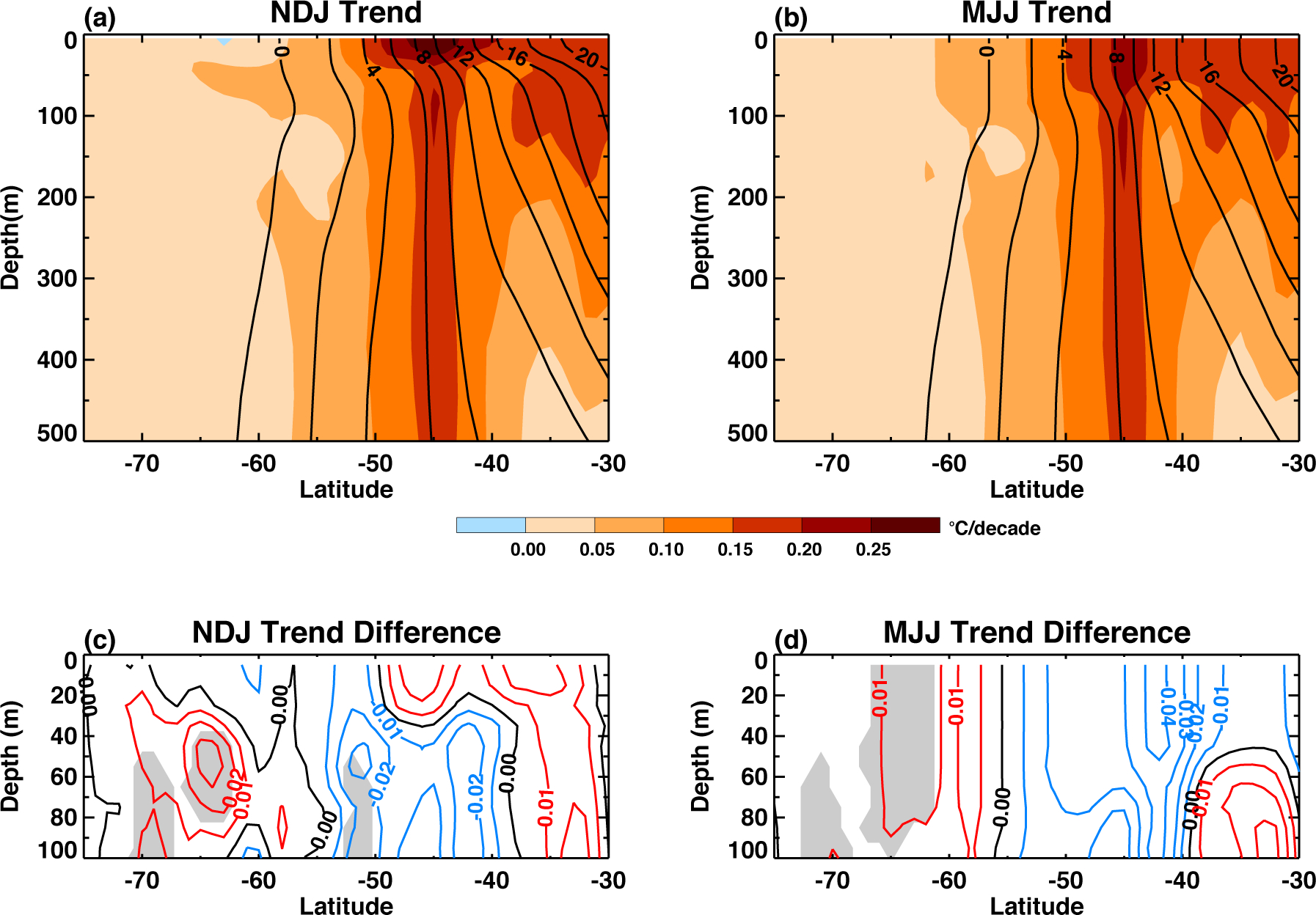
(Top) Trends of the zonal-mean ocean temperature in 1979–2010 (color shading) and climatology in 1990–2010 (contours) in (a) November-December-January and (b) May-June-July in the interactive chemistry simulations. Trends are statistically significant from zero at the 2-tailed 5% level poleward of 45°S except for the very weak surface cooling near 64°S. Equatorward of 45°S, trends with magnitude greater than about 0.15 °C/decade are statistically significant. Units of the trends (color shading) and climatology (contours) are respectively °C/decade and °C. (Bottom) Differences in zonal-mean ocean temperature trends between the interactive chemistry and prescribed ozone simulations in (c) November-December-January and (d) May-June-July. Unit is °C/decade. Shading indicates where the trends in the interactive simulations are significantly larger than those in prescribed simulations. Note that the depth ranges are different in the top and bottom panels.
Contrasting ocean temperature changes between the interactive and prescribed runs reveal some complicated structures (Figures 15 c–d). In NDJ the interactive runs have significantly stronger warming in 60°–70°S and below 40 meters with maximum warming about twice as large as in the prescribed runs, consistent with a stronger increase of the MOC upwelling. Stronger cooling is found under the surface around 64°S (not statistically significant), indicating stronger surface Ekman transport. But interactive runs also show weaker warming below about 30 meters in 40°–50°S, suggesting competing effects of the enhanced Ekman transport and MOC on ocean temperature change in this region. In MJJ the interactive runs have significantly stronger warming poleward of 55°S. Note that the edge of the Antarctic sea ice (approximately the 0 degree isothermal in Figure 15) is located between 55° and 60°S. Thus there is stronger warming under the sea ice in the interactive runs, which affects simulated Antarctic sea ice change.
Figure 16 compares the trends of the SIE in 1979–2010 (corrected for model drift based on the 100-year perpetual 1960 control simulation). The SIE drift in the control simulation is much smaller than the changes in the interactive and prescribed simulations (not shown). Both runs simulate a decrease of Antarctic SIE, in contrast to the observed Antarctic SIE increase for the past 30 years (Zwally et al. 2002). This is a common bias in the CMIP models (Turner et al. 2013), although some studies have suggested that this discrepancy might be caused by large internal variability of the Antarctic sea ice (Swart and Fyfe 2013; Polvani and Smith 2013; Gagne et al. 2015). The interesting result here is that the interactive runs have a year-round larger decrease than the prescribed runs, i.e., interactive chemistry leads to Antarctic SIE decrease. We have shown in Figure 15b that interactive simulations have significantly stronger near-surface ocean warming throughout the year, which causes enhanced year-round sea ice decrease. The SIE trend differences, however, are not statistically significant. This is probably due to the SIE’s large variability and the relatively small ensemble members in our simulations.
Figure 16:
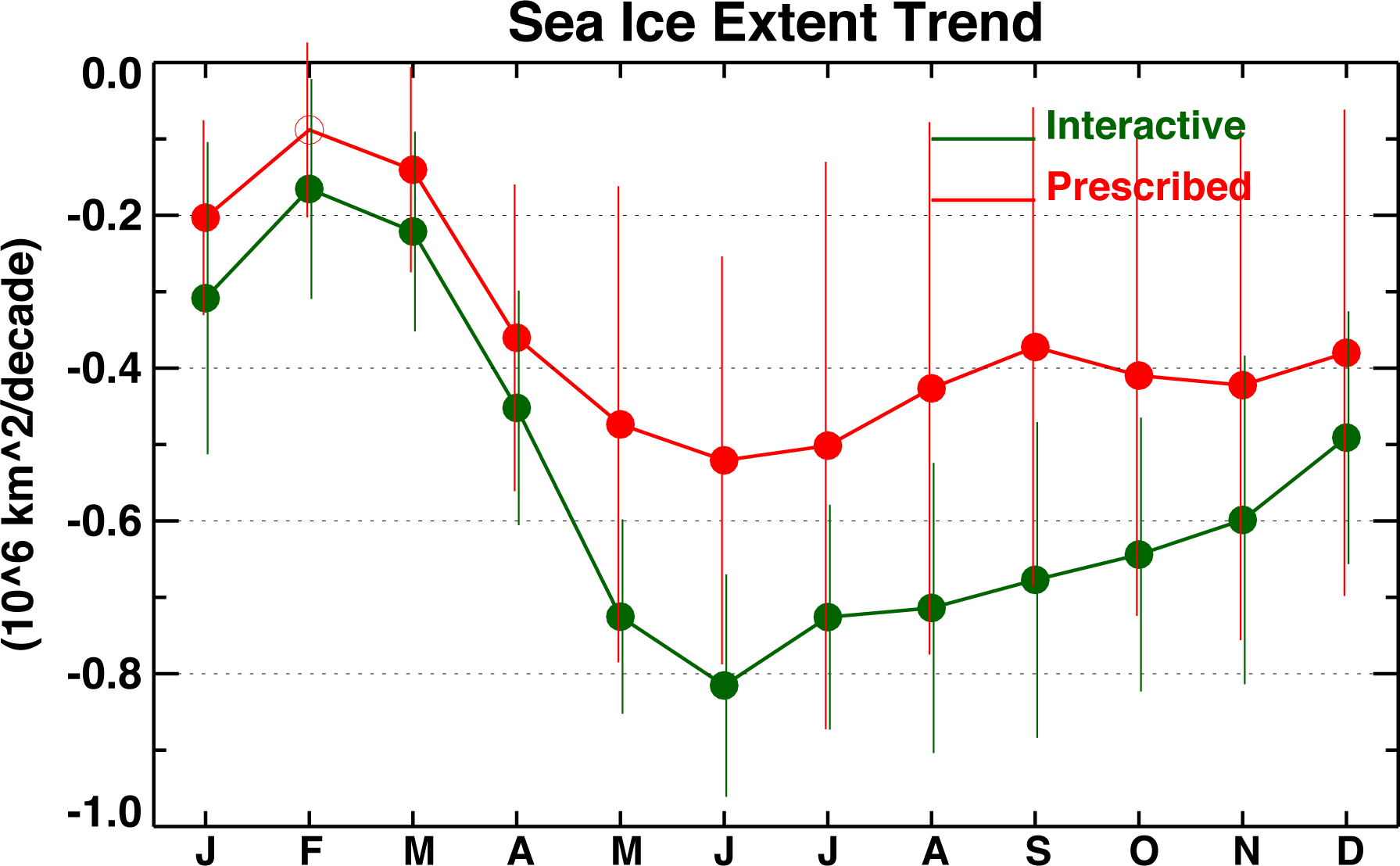
Monthly trends of the Antarctic sea ice extent in 1979–2010 in the interactive chemistry (green) and prescribed ozone (red) simulations. Error bars are the 95% confidence interval of the trends. Filled circles indicate that the trends are statistically significant at the 5% level.
The impacts of interactive stratospheric chemistry on Southern Ocean and Antarctic sea ice are qualitatively very similar to the impacts of the ozone hole that was first reported by Sigmond and Fyfe (2010). They found that, by increasing the summertime surface wind-stress over the Southern Ocean, the ozone hole acts to increase the overturning circulation, warm the upper ocean, and decrease the Antarctic sea ice. These ozone hole effects have been shown to be robust in several recent studies (Sigmond et al. 2011; Bitz and Polvani 2012; Sigmond and Fyfe 2014; Solomon et al. 2015). Our results support these findings, particularly that the observed Antarctic sea ice increase is not caused by ozone depletion.
5. Discussion and Conclusions
Stratospheric ozone depletion impacts on SH climate change are now well recognized. The most realistic way to represent stratospheric ozone forcing in climate models is to calculate ozone interactively, but current climate models commonly use prescribed monthly and zonally averaged ozone fields. The prescribed ozone fields underestimate the ozone hole forcing and lack zonal asymmetries. This study investigates how these deficiencies in the prescribed ozone affect simulations of recent climate change in the Antarctic and the Southern Ocean. Previous studies have focused on the effects of prescribed ozone on simulations of Antarctic atmosphere. Here, we also study - for the first time - the impacts on simulated changes in Southern Ocean circulation and Antarctic sea ice.
Two sets of ensemble transient simulations of 1960–2010 are conducted with GEOS-5, one with interactive stratospheric chemistry and the other with prescribed monthly- and zonal- mean ozone and six other radiatively active trace species. Radiative forcing in the stratosphere due to ozone is much more important than the other six species. Therefore differences in the simulated climate and trends between the two runs are attributed mostly to ozone differences.
The climatology from the interactive chemistry simulations is assessed with emphasis on the SH. Overall GEOS-5 simulates reasonably well the climatology of the Antarctic atmosphere, Southern Ocean circulation, and Antarctic sea ice. The model has a spring “cold pole” bias and the associated late vortex breakup. It does not correctly reproduce the observed strength and location of the maximum surface westerly wind-stress. These errors are very common in the current start-of-the-art climate models and need to be improved in order to better understand climate change over the Antarctica.
We focus on the 1979–2010 climate trends differences between the interactive chemistry and prescribed ozone simulations. The interactive runs have stronger cooling and westerly acceleration in the Antarctic lower stratosphere during austral spring and summer. The larger westerly trends in the interactive runs penetrate to the troposphere and surface. These results are consistent with previous studies (Waugh et al. 2009; Neely et al. 2014), although the largest trend differences between the interactive and prescribed runs occur in NDJ, not in DJF as reported in those studies. Interestingly, the zonal wind response to interactive chemistry increases from about 20–30% (not statistically significant) in the lower stratosphere to more than 100% (statistically significant) in the troposphere and surface. The maximum NDJ westerly surface wind-stress trend in the interactive runs is twice as large in the prescribed runs.
The significantly different surface forcing in the two simulations has important effects on changes in the Southern Ocean circulation, temperature, and Antarctic sea ice. The larger surface wind-stress trends in the interactive runs drive significantly larger changes in the NDJ Southern Ocean currents and MOC upwelling. The interactive chemistry impact on the MOC extends below 3000 m. The different changes in the MOC affect warming of the Southern Ocean. In NDJ, the stronger MOC upwelling in the interactive runs brings more upward ocean heat flux to the near surface and causes stronger warming under the sea ice. This Southern Ocean temperature warming difference persists throughout the year due to the large ocean thermal inertia, resulting in year-round larger Antarctic sea ice decrease in the interactive runs..
In conclusion, we find significant Southern Ocean responses to the interactive stratospheric chemistry: increase of the overturning circulation in NDJ, year-round warming of the near surface ocean, and decrease of the Antarctic SIE. These ocean responses originate from a larger increase of the surface wind-stress in NDJ, which is due to a stronger lower stratospheric cooling and enhanced stratosphere-troposphere coupling. Our results are consistent with studies on the effects of the ozone hole on Southern Ocean circulation, temperature, and Antarctic sea ice (Sigmond and Fyfe 2010; Sigmond et al. 2011; Bitz and Polvani 2012; Sigmond and Fyfe 2014; Solomon et al. 2015). Here we show that the interactive stratospheric chemistry can increase the ozone hole effects by up to 100% compared to prescribed ozone, highlighting the importance of correctly representing stratospheric ozone forcing in climate model in order to fully capture its effects on climate change.
The ozone hole is projected to recover in the latter half of the 21st century (Eyring et al. 2007) and the ozone impacts on the Southern Ocean and Antarctic sea ice are expected to reverse. Smith et al. (2012) reported in a modeling study that ozone recovery causes weaker summertime wind-stress, colder upper ocean temperature, and an increase of the Antarctic sea ice that acts to mitigate future sea ice loss. The CMIP models appear to capture the ozone recover effects on mitigating Antarctic sea ice decrease (Sigmond and Fyfe 2014). The findings in this study suggest that these ozone recovery effects might be significantly underestimated in models using prescribed ozone, which include most of the CMIP3 and CMIP 5 models.
In our simulations, the climatology and trends of the parameterized ocean eddy circulation are much weaker than those of the Eulerian mean circulation. Therefore the response of the residual circulation to stronger surface forcing is dominated by the increase of the Eulerian circulation. Some eddy-resolving ocean models simulate much stronger eddy response to increase of the surface forcing than the coarse-resolution ocean models do. But Bitz and Polvani (2012) found that responses of the Southern Ocean temperature and Antarctic sea ice to ozone depletion are essentially the same in an eddy-resolving and a coarse resolution ocean model. It remains to be seen whether our results can be verified in fine resolution ocean simulations.
Sigmond et al. (2010) investigated the impact of atmosphere-ocean coupling on the SAM. Their study found that atmosphere-ocean interactions increase the persistence of the SAM, but they do not impact the forced SAM response to the ozone hole. This study shows that coupling with interactive chemistry is necessary to correctly represent the response of the SAM variability to stratospheric ozone forcing. Our results also help to answer the question raised by Son et al. (2008, 2010) as why CCMs with interactive chemistry simulate stronger SAM response to ozone depletion and recovery than the CMIP4 models with prescribed ozone.
One important question that is not answered by this study is which aspect of the prescribed ozone deficiencies contributes most to the weaker trends in the prescribed runs: a weaker ozone hole forcing due to interpolation of monthly-mean values or lack of zonal asymmetries. Neely et al. (2014) compared simulations using prescribed daily zonal-mean ozone, monthly zonal-mean ozone, and interactive chemistry with the NCAR Community Earth System Model. They found that the daily-mean ozone simulations largely reduce biases in simulated SH climate and climate change in the monthly-mean ozone simulations, indicating that ozone zonal asymmetry is not an important factor in the NCAR model. However, such experiment needs to be repeated with other models to determine whether these findings based on the NCAR model are robust. Clearly more work is needed to fully understand the role of specific aspects of the ozone forcing.
Acknowledgements
This work is supported by NASA’s Modeling, Analysis and Prediction Program (MAP), and Atmospheric Composition Modeling and Analysis Program (ACMAP). D.W.W. is funded, in part, by a grant from the U.S. National Science Foundation. Computational resources for this work were provided by NASA’s High-Performance Computing though the generous award of computing time as NASA Center for Climate Simulation (NCCS) and NASA Advanced Supercomputing (NAS) Division. We thank three anonymous reviewers for their valuable comments.
Appendix
GEOS-5 Model
GEOS-5 is an Earth system model developed at National Aeronautics and Space Administration (NASA) Goddard Space Flight Center (GSFC). It integrates together the atmosphere, land, ocean, chemistry, aerosol, and sea ice models using the Earth System Modeling Framework (Hill et al. 2004). GEOS-5 is a flexible model system and it can be run with different modes, e.g., atmosphere only, coupled atmosphere-ocean, and coupled atmosphere-ocean with interactive chemistry.
GEOS-5 Atmospheric General Circulation Model (GEOS-5 AGCM) is the atmosphere only version of the GEOS-5. In this study we use the Fortuna tag of GEOS-5 AGCM, whose details are described in Molod et al. (2012). GEOS-5 Fortuna has a finite-volume dynamical core. Its atmospheric physics includes parameterization schemes for convection, larger scale precipitation and cloud cover, shortwave and longwave radiation, turbulence, gravity wave drag and a land surface model (Molod et al. 2012). GEOS-5 AGCM has 72 vertical levels with a model top at 0.01 hPa. The horizontal resolution is adjustable, but all simulations in this study use a resolution of 2.5° longitude by 2° latitude.
GEOS-5 AOGCM is the coupled ocean version of the GEOS-5. It couples GEOS-5 AGCM with the Modular Ocean Model (MOM) developed by the Geophysical Fluid Dynamics Laboratory (Griffies et al. 2005). The version of the MOM used in this study is MOM4p1 (Griffies et al. 2009). The ocean model has 50 vertical levels with a fine resolution of 10 meters in the top 200 meters. MOM uses a tripolar grid with poles over Eurasia, North America, and Antarctica. The zonal resolution is 1°. The meridional resolution is 1° in the extratropics and increases from 1° at 30° latitudes to 1/3° at the equator. The MOM4p1 is not an eddy-resolving model and the eddy fluxes are parameterized using the Gent and McWilliams (1990) scheme. MOM4p1 include parameterization schemes for penetrative shortwave radiation, horizontal friction, convection, from drag arising from unresolved mesoscale eddies, tidal mixing, vertical mixing, and overflow (Griffies et al. 2009).
The atmosphere and ocean model components exchange fluxes of momentum, heat and fresh water through a “skin layer” interface. The skin layer includes the Los Alamos Sea Ice Model, CICE (Hunke and Lipscomb 2008). CICE computes ice growth and melt subject to energy exchange. It also computes ice drift. CICE interacts with atmosphere and ocean by exchanging momentum, energy and masses through stress and fluxes.
Contributor Information
Feng Li, Goddard Earth Sciences Technology and Research, Universities Space Research Association, Columbia, Maryland, USA; Atmospheric Chemistry and Dynamics Laboratory, NASA Goddard Space Flight Center, Greenbelt, Maryland, USA.
Yury V. Vikhliaev, Goddard Earth Sciences Technology and Research, Universities Space Research Association, Columbia, Maryland, USA Global Modeling and Assimilation Office, NASA Goddard Space Flight Center, Greenbelt, Maryland, USA.
Paul A. Newman, Atmospheric Chemistry and Dynamics Laboratory, NASA Goddard Space Flight Center, Greenbelt, Maryland, USA
Steven Pawson, Global Modeling and Assimilation Office, NASA Goddard Space Flight Center, Greenbelt, Maryland, USA.
Judith Perlwitz, Cooperative Institute for Research in Environmental Sciences, University of Colorado, and Physical Sciences Division, NOAA/Earth System Research Laboratory, Boulder, Colorado, USA.
Darryn W. Waugh, Department of Earth and Planetary Science, Johns Hopkins University, Baltimore, Maryland, USA
Anne R. Douglass, Atmospheric Chemistry and Dynamics Laboratory, NASA Goddard Space Flight Center, Greenbelt, Maryland, USA
References
- Bitz CM, Polvani LM, 2012: Antarctic climate response to stratospheric ozone depletion in a fine resolution ocean climate model. Geophys. Res. Lett, 39: L20705, doi: 10.1029/2012GL053393. [DOI] [Google Scholar]
- Böning CW, Dispert A, Visbeck M, Rintoul SR, and Schwarzkopf FU; 2008: The response of the Antarctic Circumpolar Current to recent climate change. Nature Geosci. 1, 864–869. [Google Scholar]
- Cai W, 2006: Antarctic ozone depletion causes an intensification of the Southern Ocean supergyre circulation. Geophys. Res. Lett, 33, L03712, doi: 10.1029/2005GL024911. [DOI] [Google Scholar]
- Calisto M, Folini D, Wild M, and Bengtsson L, 2014: Cloud radiative forcing Intercomparison between fully coupled CMIP5 models and CERES satellite data. Ann. Geophys, 32, 793–807. [Google Scholar]
- Crook JA, Gillett NP, and Keeley SPE, 2008: Sensitivity of Southern Hemisphere climate to zonal asymmetry in ozone. Geophys. Res. Lett, 35, L07806, doi: 10.1029/2007GL032698. [DOI] [Google Scholar]
- Dee DP, and Coauthors, 2011: The ERA-Interim reanalysis: Configuration and performance of the data assimilation system. Q. J. R. Meteorol. Soc, 137, 553–597, doi: 10.1002/qj.828. [DOI] [Google Scholar]
- Delworth TL, and Coauthors, 2006: GFDL’s CM2 global coupled climate models. part I: formulation and simulation characteristics. J. Climate, 19, 643–674. [Google Scholar]
- Douglass AR, Kawa SR, 1999: Contrast between 1992 and 1997 high-latitude spring Halogen Occultation Experiment observations of lower stratospheric HCL. J. Geophys. Res, 104, 18739–18754. [Google Scholar]
- Douglass AR, Stolarski RS, Strahan SE, and Oman LD, 2012: Understanding differences in upper stratospheric ozone response to changes in chlorine and temperature as computed using CCMVal-2 models. J. Geophys. Res, 117, D16306, doi: 10.1029/2012JD017483. [DOI] [Google Scholar]
- Downes SM, Hogo AM, 2013: Southern Ocean circulation and eddy compensation in CMIP5 models. J. Climate, 26, 7198–7220. [Google Scholar]
- Eyring V, and Coauthors, 2006: Assessment of temperature, trace species, and ozone in chemistry-climate model simulations of the recent past. J. Geophys. Res, 111, D22308, doi: 10.1029/2006JD007327. [DOI] [Google Scholar]
- Farneti R, and Delworth T, 2010: The role of mesoscale eddies in the remote oceanic response to altered Southern Hemisphere winds. J. Phys. Oceanogr, 40, 2348–2354. [Google Scholar]
- Gabriel A, Peters D, Kirchner I, and Graf HF, 2007: Effect of zonally asymmetric ozone on stratospheric temperature and planetary wave propagation. Geophys. Res. Lett, 34, L06807, doi: 10.1029/2006GL028998. [DOI] [Google Scholar]
- Gent P, and McWilliams J, 1990: Isopycnal mixing in ocean circulation models. J. Phys. Oceanogr, 20, 150–155. [Google Scholar]
- Gillett NP, and Thompson DWJ, 2003: Simulation of recent Southern Hemisphere climate change. Science, 302, 273–275. [DOI] [PubMed] [Google Scholar]
- Gillett NP, and Coauthors, 2009: Sensitivity of climate to dynamically-consistent zonal asymmetries in ozone. Geophys. Res. Lett, 36, L10809, doi: 10.1029/2009GL037246. [DOI] [Google Scholar]
- Griffies SM and Coauthors, 2005: Formulation of an ocean model for global climate simulations. Ocean Science, 45–79. [Google Scholar]
- Griffies SM, Schmidt M, and Herzfeld M, 2009: Elements of mom4p1. GFDL Ocean Group Tech. Rep [Google Scholar]
- Griffies MS, and Coauthors, 2009: Coordinated Ocean-ice Reference Experiments (COREs), Ocean Modelling, 26, 1–46. [Google Scholar]
- Grytsai AV, Evtushevsky OM, Agapitov OV, Klekociuk AR, and Milinevsky GP, 2007: Structure and long-term change in the zonal asymmetry in Antarctic total ozone during spring. Annales. Geophysicae, 25, 361–374. [Google Scholar]
- Hamiberger L, Tavolato C, and Sperka S, 2012: Homogenization of the global radiosonde temperature dataset through combined comparison with reanalysis background series and neighboring stations. J. Climate, 25, 8108–8131. [Google Scholar]
- Hill C, Deluca C, Balaji, Suarez M, Da Silva A, 2004: The architecture of the Earth System Modeling Framework. Computing in Science & Engineering, 18–28. [Google Scholar]
- Hunke EC, and Lipscomb WH, 2008: CICE: The Los Alamos Sea Ice Model, Documentation and Software Manual, Version 4.0. Technical Report, Los Alamos National Laboratory. [Google Scholar]
- Kalnay E, and Coauthors, 1996: The NCEP/NCAR 40-year reanalysis project. Bull. Am. Meteorol. Soc, 77, 437–471, doi: 10.1175/1520-0477. [DOI] [Google Scholar]
- Kanamitsu M, Ebisuzaki W, Woollen J, Yang SK, Hnilo JJ, Fiorino M, and Potter GL, 2002: NCEP-DOE AMIP-II reanalysis. Bull. Am. Meteorol. Soc, 83, 1631–1643, doi: 10.1175/BAMS-83-11-1631. [DOI] [Google Scholar]
- Lauer A, and Hamilton K, 2013: Simulating clouds with global climate models: a comparison of CMIP5 results with CMIP3 and satellite data. J. Climate, 26, 3823–3845. [Google Scholar]
- Lee T, Waliser DE,, Li JLF, Landerer FW,, and Gierach MM, 2013: Evaluation of CMIP3 and CMIP5 wind stress climatology using satellite measurements and atmospheric reanalysis products. J. Climate, 26, 5810–5826. [Google Scholar]
- Lenton A, Codron F, Bopp L, Metzl N, Cadule P, Tagliabue A, and Sommer JL, 2009: Stratospheric ozone depletion reduces ocean carbon uptake and enhances ocean acidification. Geophys. Res. Lett, 36, L12606, doi: 10.1029/2009GL038227. [DOI] [Google Scholar]
- Levitus SE, 1982: Climatological atlas of the world ocean NOAA Professional paper 13, US Government Printing Office, Washington DC. [Google Scholar]
- Li F, Austin J, and Wilson J, 2008: The strength of the Brewer-Dobson circulation in a changing climate: coupled chemistry-climate simulations. J. Climate, 21, 40–57. [Google Scholar]
- Marshall J, and Speer K, 2012: Closure of the meridional overturning circulation through Southern Ocean upwelling. Nature Geophys, 5, 171–180. [Google Scholar]
- McLandress C, Shepherd TG, Polavarapu S, and Beagley SR, 2011: Is missing orographic gravity wave drag near 60S the cause of the stratospheric zonal wind biases in chemistry-climate models? J. Climate, 69, 802–818. [Google Scholar]
- Molod A, Takacs L, Suarez M, Bacmeister J, Song IS, and Eichmann A, 2012: The GEOS-5 atmospheric general circulation model: Mean climate and development from MERRA to Fortuna. Technical Report Series on Global Modeling and Data Assimilation, 28, [Available at: http://gmao.gsfc.nasa.gov/pubs/docs/Molod484.pdf.] [Google Scholar]
- Neely RR, Marsh DR, Smith KL, Davis SM, and Polvani LM, 2014: Biases in southern hemisphere climate trends induced by coarsely specifying the temporal resolution of stratospheric ozone. Geophys. Res. Lett, 41, 8602–8610, doi: 10.1002/2014GL061627. [DOI] [Google Scholar]
- Nathan TR, and Cordero EC, 2007: An ozone-modified refractive index for vertically propagating planetary waves. J. Geophys. Res, 112, D02105, doi: 10.1029/2006JD007357. [DOI] [Google Scholar]
- Oman LD, and Douglass AR, 2014: Improvements in total column ozone in GEOSCCM and comparisons with a new ozone-depleting substances scenario. J. Geophys. Res, 119, 5613–5624, doi: 10.1002/2014JD021590. [DOI] [Google Scholar]
- Pawson S, Stolarski RS, Douglass AR, Newman PA, Nielsen JE, Frith SM, and Gupta ML, 2008: Goddard Earth Observing System chemistry climate model simulations of stratosphere ozone temperature coupling between 1950 and 2005. J. Geophys. Res, 113, D12103, doi: 10.1029/2007JD009511. [DOI] [Google Scholar]
- Perlwitz J, Pawson S, Fogt RL, Nielsen JE, and Neff WD, 2008: Impact of stratospheric ozone hole recovery on Antarctic climate. Geophys. Res. Lett, 35, L08714, doi: 10.1029/2008GL033317 [DOI] [Google Scholar]
- Polvani LM, and Smith KL, 2013: Can natural variability explain observed Antarctic sea ice trends? New modeling evidence from CMIP5, Geophys. Res. Lett, 40, 3195–3199, doi: 10.1002/grl.50578. [DOI] [Google Scholar]
- Previdi M, and Polvani LM, 2014: Climate system response to stratospheric ozone depletion and recovery. Q. J. R. Meteorol. Soc, doi: 10.1002/qj.2330. [DOI] [Google Scholar]
- Randel WJ, and Wu F, 1999: Cooling of the Arctic and Antarctic polar stratospheres due to ozone depletion. J. Climate, 12, 1467–1479. [Google Scholar]
- Reynolds RW, Rayner NA, Smith TM, Stokes DC, and Wang W, 2002: An improved in situ and satellite SST analysis for climate. J. Climate, 15, 1609–1625. [Google Scholar]
- Rienecker MM, and Coauthors, 2011. MERRA: NASA’s Modern-Era Retrospective Analysis for Research and Applications. J. Climate, 24, 3624–3648, doi: 10.1175/JCLI-D-11-00015.1. [DOI] [PMC free article] [PubMed] [Google Scholar]
- Russell JL, Dixon KW, Gnanadesikan AG, Stouffer RJ, and Toggweiler JR, 2006a: The southern hemisphere westerlies in a warming world: propping open the door to the deep ocean. J. Climate, 16, 6382–6390. [Google Scholar]
- Santer B, Wigley T, Boyle J, Gaffen D, Hnilo J, Nychka D, Parker D, and Taylor KE, 2000: Statistical significance of trends and trend differences in layer-average atmospheric temperature time series. J. Geophys. Res, 105, 7337–7356, doi: 10.1029/1999JD901105. [DOI] [Google Scholar]
- Sassi F, Boville BA, Kinnison D, and Garcia RR, 2005: The effects of interactive ozone chemistry on simulations of the middle atmosphere. Geophys. Res. Lett, 32, L07811, doi: 10.1029/2004GL022131. [DOI] [Google Scholar]
- Sen Gupta A, Santoso A, Taschetto AS, Ummenhofer CC, Trevena J, and England MH, 2009: Projected changes to the Southern Hemisphere ocean and sea ice in the IPCC AP4 climate models. J. Climate, 22, 3047–3078. [Google Scholar]
- Shine KP, 1986:. On the modeled thermal response of the Antarctic stratosphere to a depletion of ozone. Geophys. Res. Lett, 13, 1331–1334. [Google Scholar]
- Sigmond M, and Fyfe JC, 2010: Has the ozone hole contributed to increased Antarctic sea ice extent? Geophys. Res. Lett, 37, L18502, doi: 10.1029/2010GL044301. [DOI] [Google Scholar]
- Sigmond M, Fyfe JC, and Scinocca JF, 2010: Does the ocean impact the atmospheric response to stratospheric ozone depletion? Geophys. Res. Lett, 37, L12706, doi: 10.1029/2010GL043773. [DOI] [Google Scholar]
- Sigmond M, Reader MC, Fyfe JC, and Gillett NP, 2011: Drivers of past and future Southern Ocean change: Stratospheric ozone versus greenhouse gas impacts. Geophys. Res. Lett, 38, L12601, doi: 10.1029/2011GL047120. [DOI] [Google Scholar]
- Sigmond M, and Fyfe JC, 2014: The Antarctic sea ice response to the ozone hole in climate models. J. Climate, 27, 1336–1342. [Google Scholar]
- Smith KL, Polvani LM, and Marsh DR, 2012: Mitigation of 21st century Antarctic sea ice loss by stratospheric ozone recovery, Geophys. Res. Lett, 39, L20701, doi: 10.1029/2012GL053325. [DOI] [Google Scholar]
- Solomon A, Polvani LM, Abernathy R and Smith KL, 2015: The impact of ozone depleting substances on the circulation, temperature, and salinity of the Southern Ocean: An attribution study with CESM1(WACCM),. Geophys. Res. Lett, 42, DOI: 10.1002/2015GL064744. [DOI] [Google Scholar]
- Son SW, and Coauthors, 2008: The impact of stratospheric ozone recovery on the Southern Hemisphere westerly jet. Science, 296, 895–899. [DOI] [PubMed] [Google Scholar]
- Son SW, and Coauthors, 2010: Impact of stratospheric ozone on Southern Hemisphere circulation change: A multimodel assessment. J. Geophys. Res, 115, D00M07, doi: 10.1029/2010JD014271. [DOI] [Google Scholar]
- Spence P, Fyfe JC, Montenegro A, and Weaver AJ, 2010: Southern Ocean response to strengthening winds in an eddy permitting global climate model. J. Climate, 23, 5332–5343. [Google Scholar]
- SPARC CCMVal, 2010: SPARC Report on the Evaluation of Chemistry-Climate Models, (Eds.), SPARC Report No. 5,WCRP-132, WMO/TD-No. 1526. http://www.atmosp.physics.utoronto.ca/SPARC.
- Stolarski RS, Douglass AR, Gupta M, Newman PA, Pawson S, Schoeberl MR, and Nielsen JE, 2006: An ozone increase in the Antarctic summer stratosphere: A dynamical response to the ozone hole, Geophys. Res. Lett, 33, L21805, doi: 10.1029/2006GL026820. [DOI] [Google Scholar]
- Strahan SE, and Coauthors, 2011: Using transport diagnostics to understand chemistry climate model ozone simulations. J. Geophys. Res, 116, D17302, doi: 10.1029/2010JD015360. [DOI] [Google Scholar]
- Swart NC, and Fyfe JC, 2012: Observed and simulated changes in the Southern Hemisphere surface westerly wind-stress. Geophys. Res. Lett, 39, L16711, doi: 10.1029/2012GL052810. [DOI] [Google Scholar]
- Swart NC, and Fyfe JC, 2013: The influence of recent Antarctic ice sheet retreat on simulated sea ice area trends, Geophys. Res. Lett, 40, 4328–4332, doi: 10.1002/grl.50820. [DOI] [Google Scholar]
- Thompson DWJ, and Wallace JM, 2000: Annular Modes in the extratropical circulation: Part I: month-to-month variability. J. Climate, 13, 1000–1016. [Google Scholar]
- Thompson DWJ, and Solomon S, 2002: Interpretation of recent Southern Hemisphere climate change. Science, 296, 895–899. [DOI] [PubMed] [Google Scholar]
- Thompson DWJ, Solomon S, Kushner PJ, England MH, Grise KM, and Karoly DJ, 2012: Signatures of the Antarctic ozone hole in Southern Hemisphere surface climate change. Nature Geosci, doi: 10.1038/NGEO1296. [DOI] [Google Scholar]
- Turner J, Bracegirdle T, Phillips T, Marshall G, and Hosking J, 2013: An initial assessment of Antarctic sea ice extent in the CMIP5 models. J. Climate, 26, 1473–1484, doi: 10.1175/JCLI-D-12-00068.1. [DOI] [Google Scholar]
- Waugh DW, Randel WJ, Pawson S, Newman PA, and Nash ER, 1999: Persistence of the lower stratospheric polar vortices. J. Geophys. Res, 104, 27191–27201. [Google Scholar]
- Waugh DW, Oman L, Newman PA, Stolarski RS, Pawson S, Nielsen JE, and Perlwitz J, 2009: Effect of zonal asymmetries in stratospheric ozone on simulated Southern Hemisphere climate trends. Geophys. Res. Lett, 36, L18701, doi: 10.1029/2009GL040419. [DOI] [Google Scholar]
- Waugh DW, Primeau F, Devries T, and Holzer M, 2013: Recent changes in the ventilation of the southern oceans. Science, 339, 568–570. [DOI] [PubMed] [Google Scholar]
- Wigley TML, 2006: Appendix A: Statistical issues regarding trends. In temperature trends in the lower atmosphere: steps for understanding and reconciling differences Karl TR, Hassol SJ, Miller CD, Murray WL (eds). A Report by the U.S. Climate Change Science Program and the Subcommittee on Global Change Research, Washington DC. [Google Scholar]
- Zwally HJ, Comiso JC, Parkinson CL, Cavalieri DJ, and Gloersen P, 2002: Variability of Antarctic sea ice 1979–1998. J. Geophys. Res, 107, 3041. doi: 10.1029/2000JC000733. [DOI] [Google Scholar]


